ICOM orporated 285200 VHF-FM Marine Transceiver User Manual IC M422 FCC
ICOM Incorporated VHF-FM Marine Transceiver IC M422 FCC
Manual
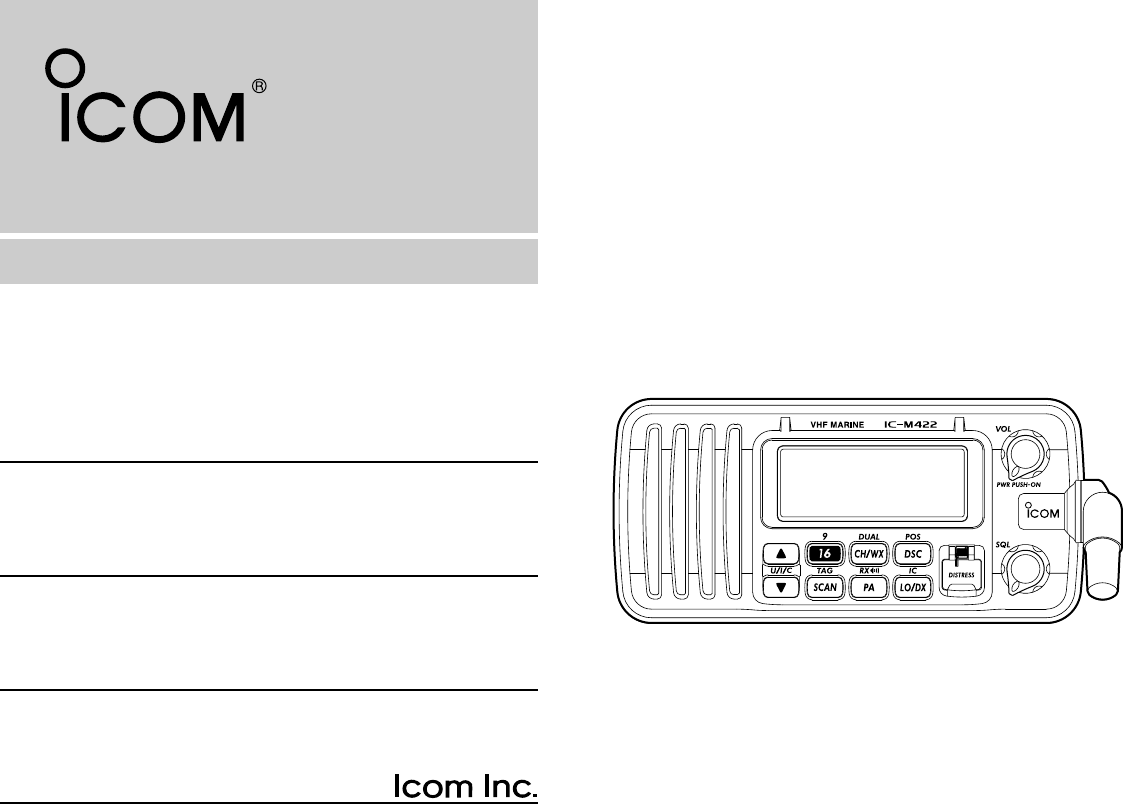
INSTRUCTION MANUAL
New2001
iM422
VHF MARINE TRANSCEIVER
!IC-M422_FCC.qxd 05.1.14 11:30 AM Page A (1,1)
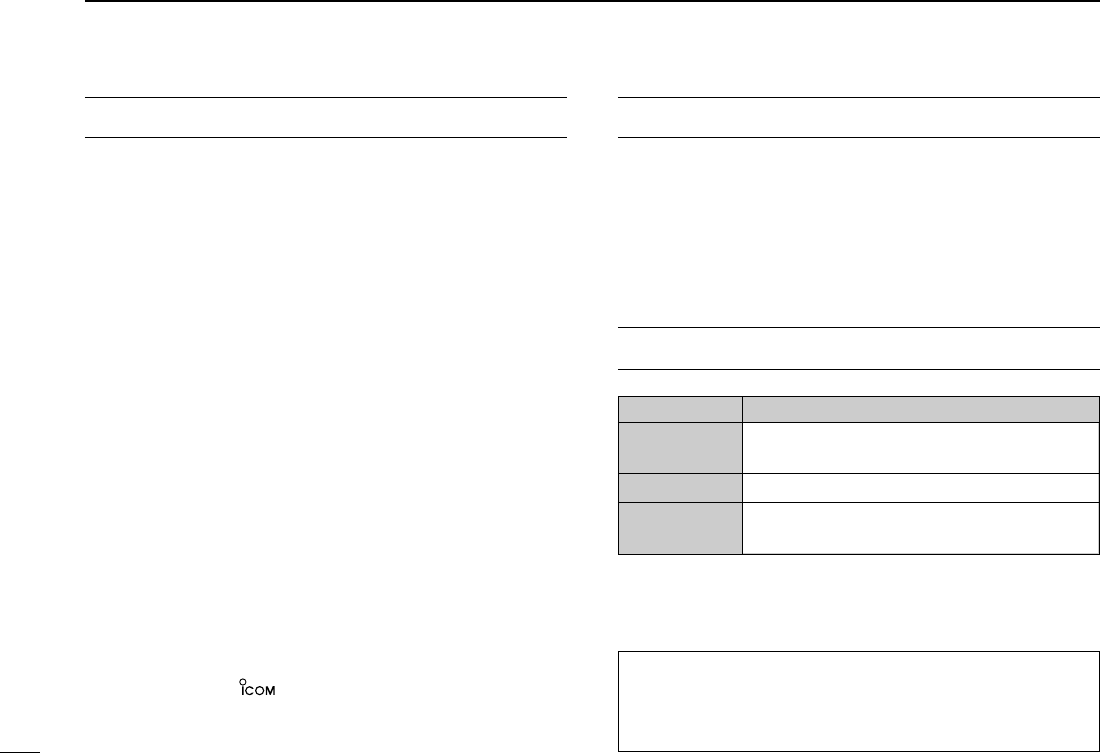
i
New2001
FOREWORD
Thank you for purchasing this Icom product. The
IC-M422
VHF MARINE TRANSCEIVERS
are designed and built
with Icom’s state of the art technology and craftsmanship.
With proper care, this product should provide you with years
of trouble-free operation.
We want to take a couple of moments of your time to thank
you for making the IC-M422 your radio of choice, and hope
you agree with Icom’s philosophy of “technology first.” Many
hours of research and development went into the design of
your IC-M422.
D
FEATURES
❍Large 2-digit Channel with scrolling comment
❍Easy to hear speaker
❍Built-in DSC meets RTCM SC101 requirement
❍Rugged waterproof construction
❍Optional COMMANDMIC II™
IMPORTANT
READ ALL INSTRUCTIONS carefully and completely
before using the transceiver.
SAVE THIS INSTRUCTION MANUAL — This in-
struction manual contains important operating instructions for
the IC-M422.
EXPLICIT DEFINITIONS
WORD DEFINITION
RWARNING!
CAUTION
NOTE
Personal injury, fire hazard or electric shock
may occur.
Equipment damage may occur.
Recommended for optimum use. No risk of
personal injury, fire or electric shock.
CLEAN THE TRANSCEIVER AND MICROPHONE THOR-
OUGHLY WITH FRESH WATER after exposure to water
including salt water, otherwise, the keys and switches may
become inoperable due to salt crystallization.
Icom, Icom Inc. and the logo are registered trademarks of Icom Incor-
porated (Japan) in the United States, the United Kingdom, Germany, France,
Spain, Russia and/or other countries. COMMANDMIC is a registered trade-
mark of Icom Incorporated (Japan) in the United states.
!IC-M422_FCC.qxd 05.1.14 11:30 AM Page i (1,1)
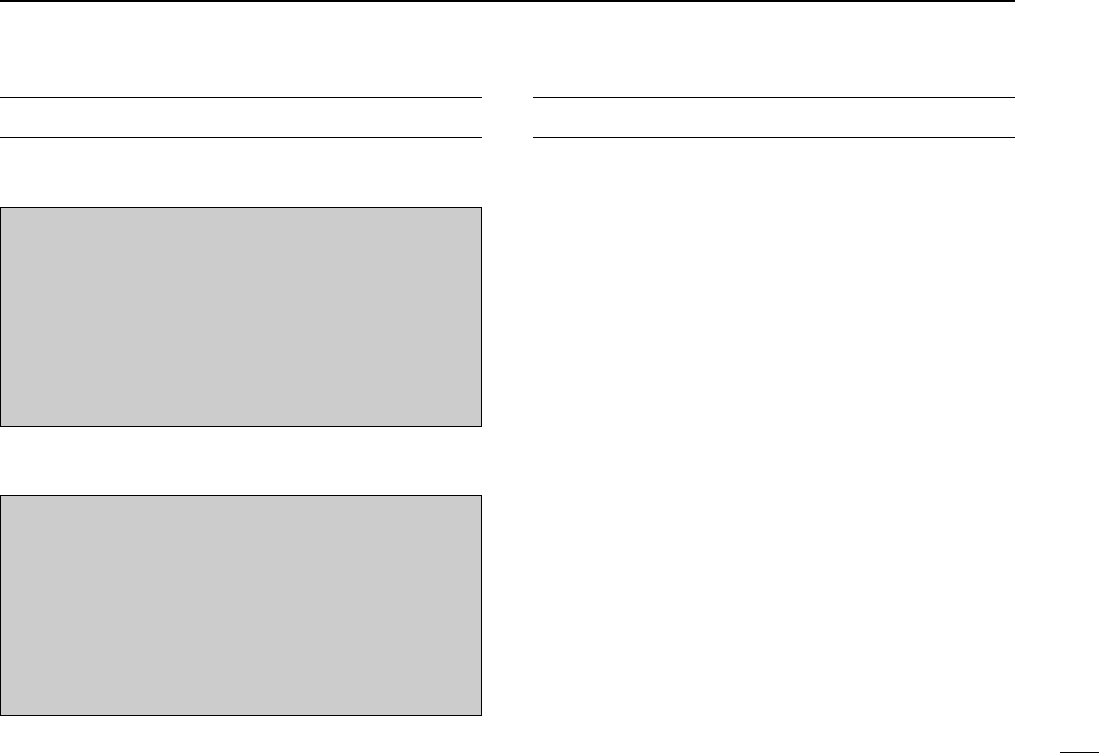
ii
IN CASE OF EMERGENCY
If your vessel requires assistance, contact other vessels and
the Coast Guard by sending a distress call on Channel 16.
Or, transmit your distress call using digital selective calling on
Channel 70.
NOTE
A WARNING STICKER is supplied with the transceiver.
To comply with FCC regulations, this sticker must be affixed in
such a location as to be readily seen from the operating con-
trols of the radio. Make sure the chosen location is clean and
dry before applying the sticker.
USING DIGITAL SELECTIVE CALLING (Ch 70)
DISTRESS CALL PROCEDURE
1. While lifting up the key cover, push and hold
[DISTRESS] for 5 sec. until you hear 5 short beeps
change to one long beep.
2. Wait for an acknowledgment from a coast station.
• Channel 16 is automatically selected.
3. Push and hold [PTT], then transmit the appropriate
information as listed above.
USING CHANNEL 16
DISTRESS CALL PROCEDURE
1. “MAYDAY MAYDAY MAYDAY.”
2. “THIS IS ...............” (name of vessel)
3. Your call sign or other indication of the vessel (AND 9-
digit DSC ID if you have one).
4. “LOCATED AT ...............” (your position)
5. The nature of the distress and assistance required.
6. Any other information which might facilitate the rescue.
New2001
!IC-M422_FCC.qxd 05.1.14 11:30 AM Page ii (1,1)
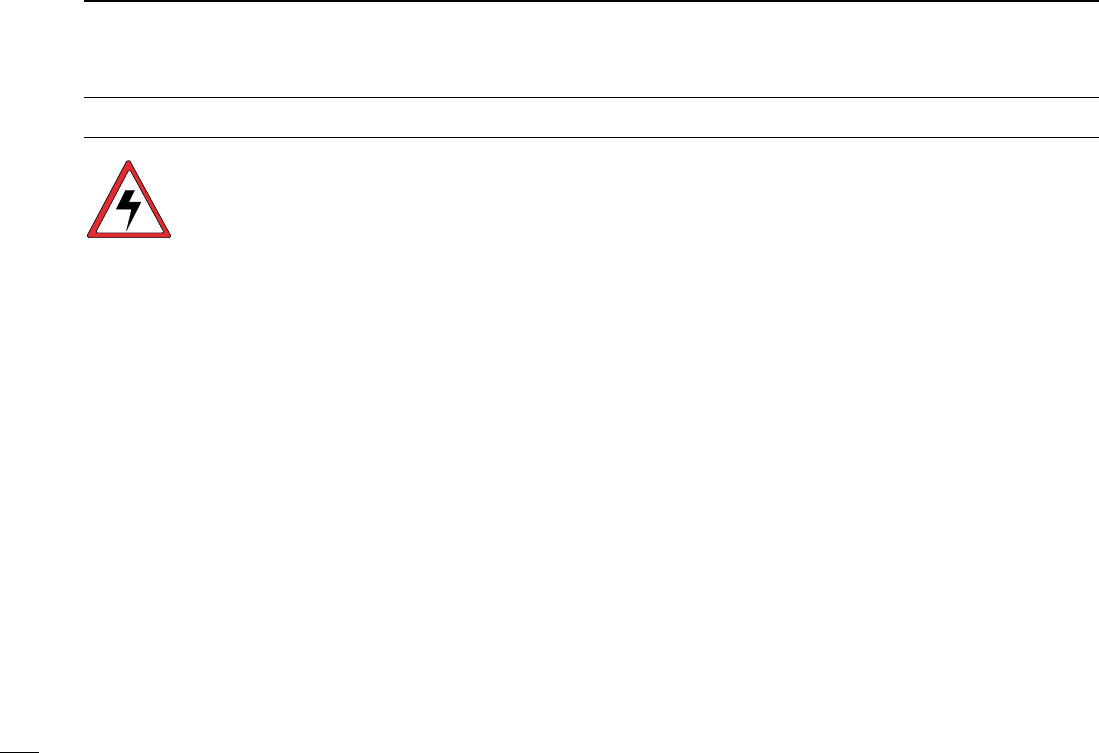
iii
New2001
RADIO OPERATOR WARNING
Icom requires the radio operator to meet the
FCC Requirements for Radio Frequency Expo-
sure. An omnidirectional antenna with gain not
greater than 9 dBi must be mounted a minimum
of 5 meters (measured from the lowest point of
the antenna) vertically above the main deck and
all possible personnel. This is the minimum safe separation
distance estimated to meet all RF exposure compliance re-
quirements. This 5 meter distance is based on the FCC Safe
Maximum Permissible Exposure (MPE) distance of 3 meters
added to the height of an adult (2 meters) and is appropriate
for all vessels.
For watercraft without suitable structures, the antenna must
be mounted so as to maintain a minimum of 1 meter vertically
between the antenna, (measured from the lowest point of the
antenna), to the heads of all persons AND all persons must
stay outside of the 3 meter MPE radius.
Do not transmit with radio and antenna when persons are
within the MPE radius of the antenna, unless such persons
(such as driver or radio operator) are shielded from antenna
field by a grounded metallic barrier. The MPE Radius is the
minimum distance from the antenna axis that person should
maintain in order to avoid RF exposure higher than the allow-
able MPE level set by FCC.
WARNING
FAILURE TO OBSERVE THESE LIMITS MAY ALLOW
THOSE WITHIN THE MPE RADIUS TO EXPERIENCE RF
RADIATION ABSORPTION WHICH EXCEEDS THE FCC
MAXIMUM PERMISSIBLE EXPOSURE (MPE) LIMIT.
IT IS THE RESPONSIBILITY OF THE RADIO OPERATOR
TO ENSURE THAT THE MAXIMUM PERMISSIBLE EXPO-
SURE LIMITS ARE OBSERVED AT ALL TIMES DURING
RADIO TRANSMISSION. THE RADIO OPERATOR IS TO
ENSURE THAT NO BYSTANDERS COME WITHIN THE
RADIUS OF THE MAXIMUM PERMISSIBLE EXPOSURE
LIMITS.
Determining MPE Radius
THE MAXIMUM PERMISSIBLE EXPOSURE (MPE) RA-
DIUS HAS BEEN ESTIMATED TO BE A RADIUS OF
ABOUT 3M PER OET BULLETIN 65 OF THE FCC.
THIS ESTIMATE IS MADE ASSUMING THE MAXIMUM
POWER OF THE RADIO AND ANTENNAS WITH A MAXI-
MUM GAIN OF 9dBi ARE USED FOR A SHIP MOUNTED
SYSTEM.
!IC-M422_FCC.qxd 05.1.14 11:30 AM Page iii (1,1)
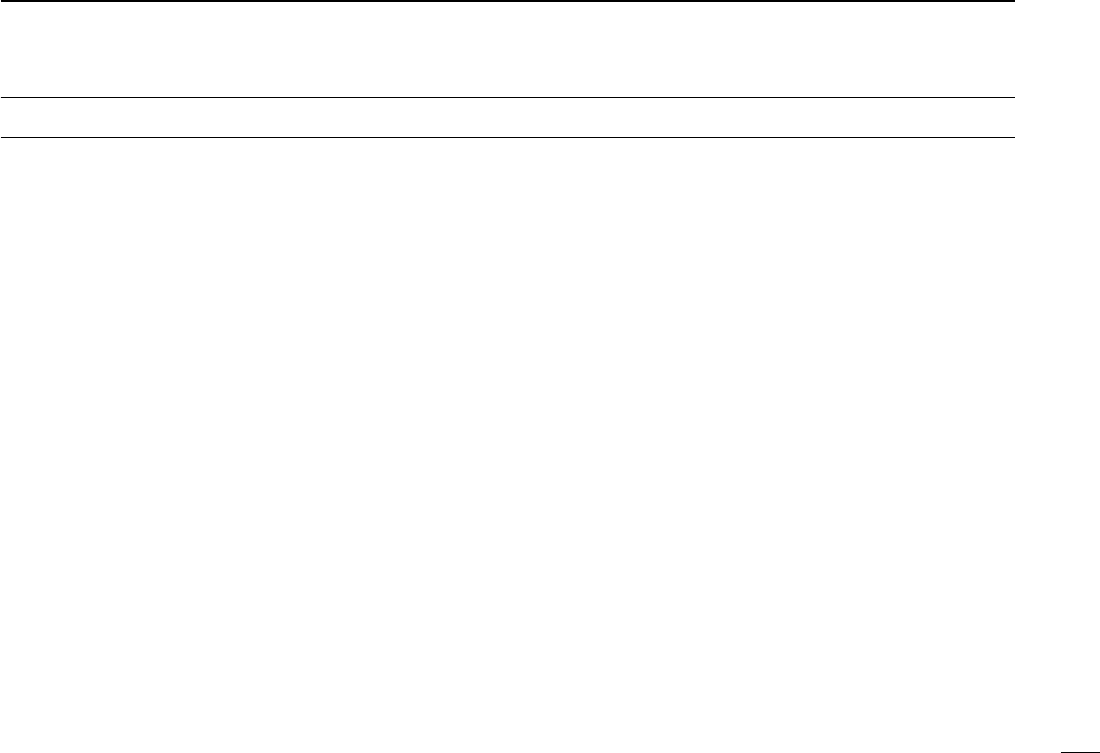
iv
New2001
FOREWORD …………………………………………………………… i
IMPORTANT …………………………………………………………… i
EXPLICIT DEFINITIONS ……………………………………………… i
IN CASE OF EMERGENCY ………………………………………… ii
NOTE …………………………………………………………………… ii
RADIO OPERATOR WARNING …………………………………… iii
TABLE OF CONTENTS ……………………………………………… iv
PRECAUTIONS ……………………………………………………… v
1 OPERATING RULES ……………………………………………… 1
2 PANEL DESCRIPTION ………………………………………… 2–4
■Front panel ……………………………………………………… 2
■Microphone ……………………………………………………… 3
■Function display ………………………………………………… 4
3 BASIC OPERATION ………………………………………… 5–10
■Channel selection ……………………………………………… 5
■Receiving and transmitting …………………………………… 6
■Call channel programming……………………………………… 8
■Channel comments……………………………………………… 9
■Microphone lock function ……………………………………… 9
■Display backlighting …………………………………………… 9
4 SCAN OPERATION ………………………………………… 10–11
■Scan types ……………………………………………………… 10
■Setting tag channels …………………………………………… 11
■Starting a scan ………………………………………………… 11
5 DUALWATCH/TRI-WATCH……………………………………… 12
■Description ……………………………………………………… 12
■Operation ……………………………………………………… 12
6 DSC OPERATION …………………………………………… 13–29
■MMSI code programming …………………………………… 13
■MMSI code check ……………………………………………… 13
■DSC individual ID ……………………………………………… 14
■Position indication……………………………………………… 15
■Distress call …………………………………………………… 16
■Transmitting DSC calls………………………………………… 17
■Receiving DSC calls…………………………………………… 26
7 SET MODE …………………………………………………… 31–33
■SET mode programming ……………………………………… 31
■SET mode items ……………………………………………… 31
8 CHANNEL LIST ………………………………………………… 34
9 SPECIFICATIONS AND OPTIONS …………………………… 35
■Specifications ………………………………………………… 35
■Options ………………………………………………………… 35
TABLE OF CONTENTS
!IC-M422_FCC.qxd 05.1.14 11:30 AM Page iv (1,1)
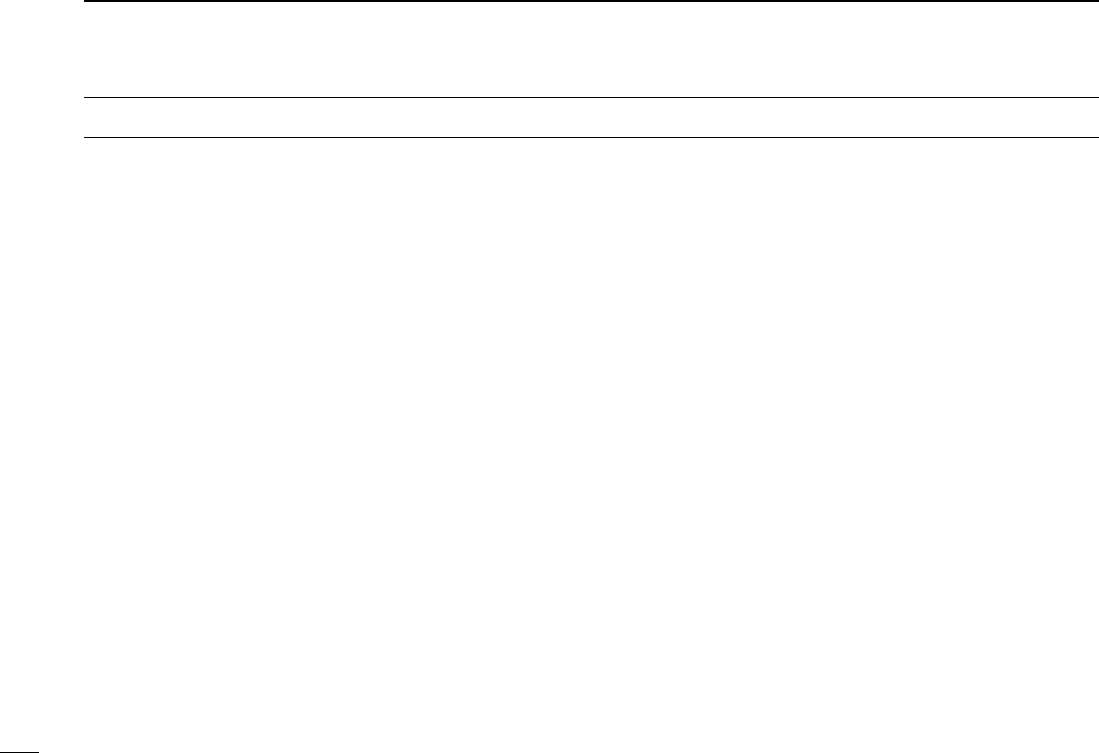
v
New2001
PRECAUTIONS
RWARNING! NEVER connect the transceiver to an AC
outlet. This may pose a fire hazard or result in an electric
shock.
CAUTION: Changes or modifications to this device, not ex-
pressly approved by Icom Inc., could void your authority to
operate this device under FCC regulations.
NEVER connect the transceiver to a power source of more
than 16 V DC or use reverse polarity. This will ruin the trans-
ceiver.
NEVER cut the DC power cable between the DC plug and
fuse holder. If an incorrect connection is made after cutting,
the transceiver may be damaged.
NEVER place the transceiver where normal operation of the
vessel may be hindered or where it could cause bodily injury.
KEEP the transceiver at least 3.3 ft (1 m) away from the
ship’s navigation compass.
DO NOT use or place the transceiver in areas with temper-
atures below –4°F (–20°C) or above +140°F (+60°C) or, in
areas subject to direct sunlight, such as the dashboard.
AVOID the use of chemical agents such as benzine or al-
cohol when cleaning, as they may damage the transceiver
surfaces.
BE CAREFUL! The transceiver rear panel will become
hot when operating continuously for long periods.
Place the transceiver in a secure place to avoid inadvertent
use by children.
BE CAREFUL! The transceiver and optional HM-157
COMMANDMIC II
™ employ waterproof construction, which cor-
responds to IPX waterproof specification, Grade 7
(1 m/30 min.). However, once the transceiver or microphone
has been dropped, waterproofing cannot be guaranteed due
to the fact that the case may be cracked, or the waterproof
seal damaged, etc.
!IC-M422_FCC.qxd 05.1.14 11:30 AM Page v (1,1)
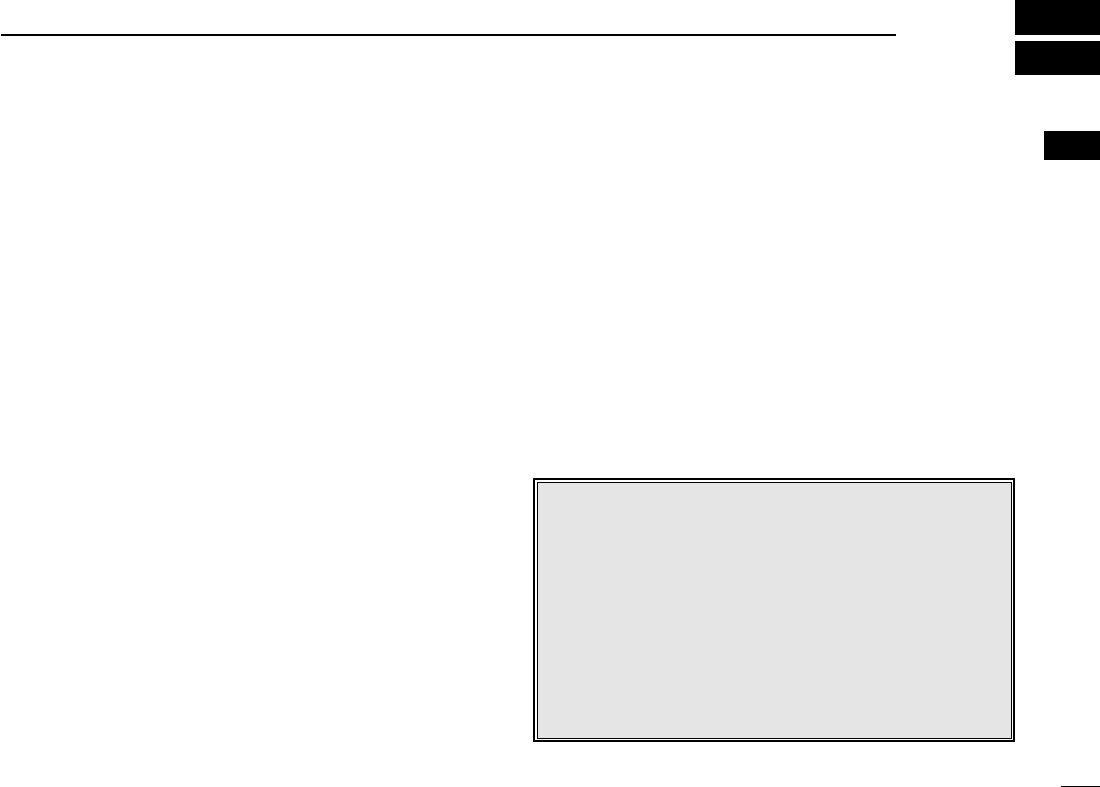
1
1
OPERATING RULES
DDPRIORITIES
• Read all rules and regulations pertaining to priorities and
keep an up-to-date copy handy. Safety and distress calls
take priority over all others.
• You must monitor Channel 16 when you are not operating
on another channel.
• False or fraudulent distress signals are prohibited and pun-
ishable by law.
DDPRIVACY
• Information overheard but not intended for you cannot law-
fully be used in any way.
• Indecent or profane language is prohibited.
DDRADIO LICENSES
(1) SHIP STATION LICENSE
You must have a current radio station license before using the
transceiver. It is unlawful to operate a ship station which is not
licensed.
Inquire through your dealer or the appropriate government
agency for a Ship-Radiotelephone license application. This
government-issued license states the call sign which is your
craft’s identification for radio purposes.
(2) OPERATOR’S LICENSE
A Restricted Radiotelephone Operator Permit is the license
most often held by small vessel radio operators when a radio
is not required for safety purposes.
The Restricted Radiotelephone Operator Permit must be
posted or kept with the operator. Only a licensed radio opera-
tor may operate a transceiver.
However, non-licensed individuals may talk over a transceiver
if a licensed operator starts, supervises, ends the call and
makes the necessary log entries.
Keep a copy of the current government rules and regulations
handy.
Radio license for boaters (U.S.A. only)
The Telecommunications Act of 1996 permits recreational
boaters to have and use a VHF marine radio, EPIRB, and
marine radar without having an FCC ship station license.
Boaters traveling on international voyages, having an HF
single sideband radiotelephone or marine satellite termi-
nal, or required to carry a marine radio under any other
regulation must still carry an FCC ship station license. For
further information, see the FCC Ship Radio Stations Fact
Sheet.
1
!IC-M422_FCC.qxd 05.1.14 11:30 AM Page 1 (1,1)
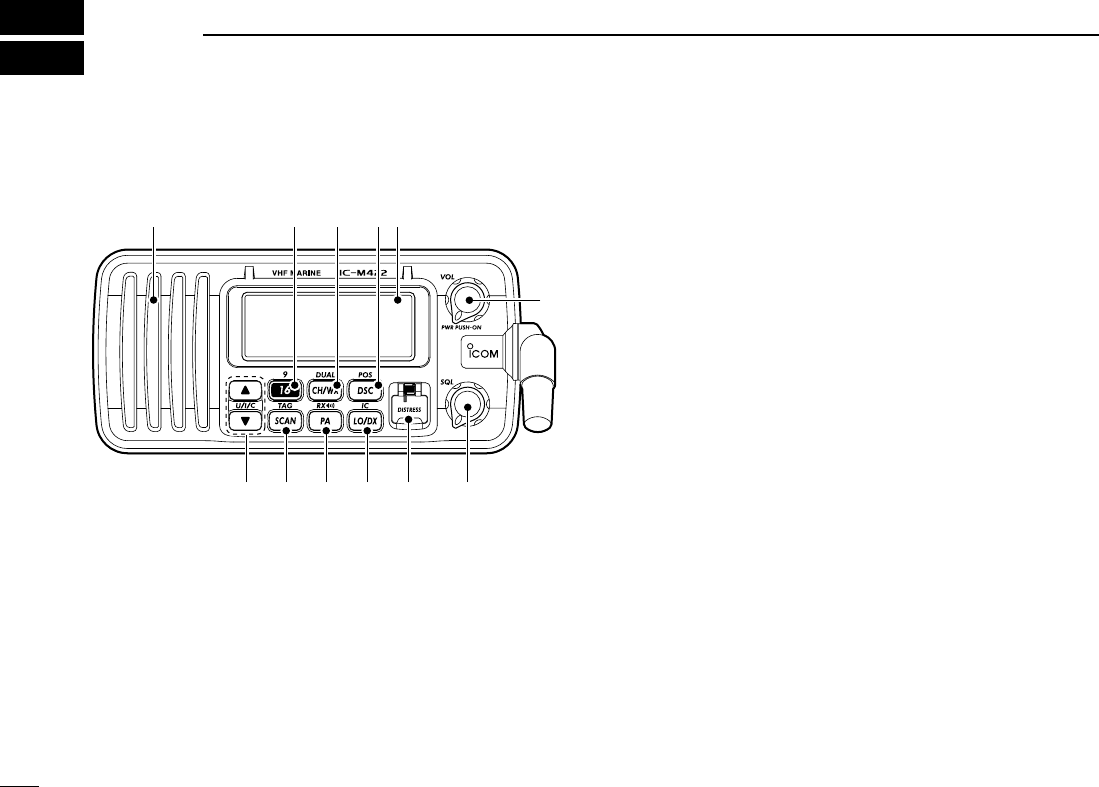
2
PANEL DESCRIPTION
New2001
2
■Front panel
qCHANNEL 16/CALL CHANNEL KEY [16•9]
➥Push to select Channel 16. (p. 5)
➥Push for 1 sec. to select call channel. (p. 5)
•“CALL” appears when call channel is selected.
➥Push for 3 sec. to enter call channel programming con-
dition when call channel is selected. (p. 8)
➥While pushing [CH/WX•DUAL], push to enter the chan-
nel comments programming condition. (p. 9)
➥While turning power ON, push to enter set mode. (p. 31)
wCHANNEL/WEATHER CHANNEL KEY [CH/WX•DUAL]
➥Toggles between regular channels and weather chan-
nel when pushed momentarily. (p. 6)
➥Push for 1 sec. to start dualwatch or tri-watch. (p. 12)
➥Push to stop dualwatch or tri-watch when either is acti-
vated.
eDSC/POSITION KEY [DSC•POS]
➥Push to select the DSC menu. (p. 13)
➥Push for 1 sec. to show the current position from a GPS
receiver. (p. 15)
rPOWER/VOLUME CONTROL [VOL]
➥Push for 1 sec. to turn power ON and OFF.
➥Rotate to adjust the audio level. (p. 7)
tSQUELCH CONTROL [SQL]
Rotate to set the squelch threshold level. (p. 7)
yDISTRESS KEY [DISTRESS]
Push for 5 sec. to transmit a distress call. (p. 16)
uATTENUATOR/INTERCOM KEY [Lo/DX•IC]
➥Push to toggle the attenuator function ON or OFF. (p. 7)
•“LOC” appears when the Attenuator function is turned ON.
➥Push for 1 sec. to activate an optional intercom function.
(p. ?)
➥Push for 1 sec. to call the optional HM-157
COMMAND
-
MIC II
™ while in Intercom mode. (p. ?)
qwe
r
Speaker
Function
display (p.4)
!0 oiuy t
!IC-M422_FCC.qxd 05.1.14 11:30 AM Page 2 (1,1)
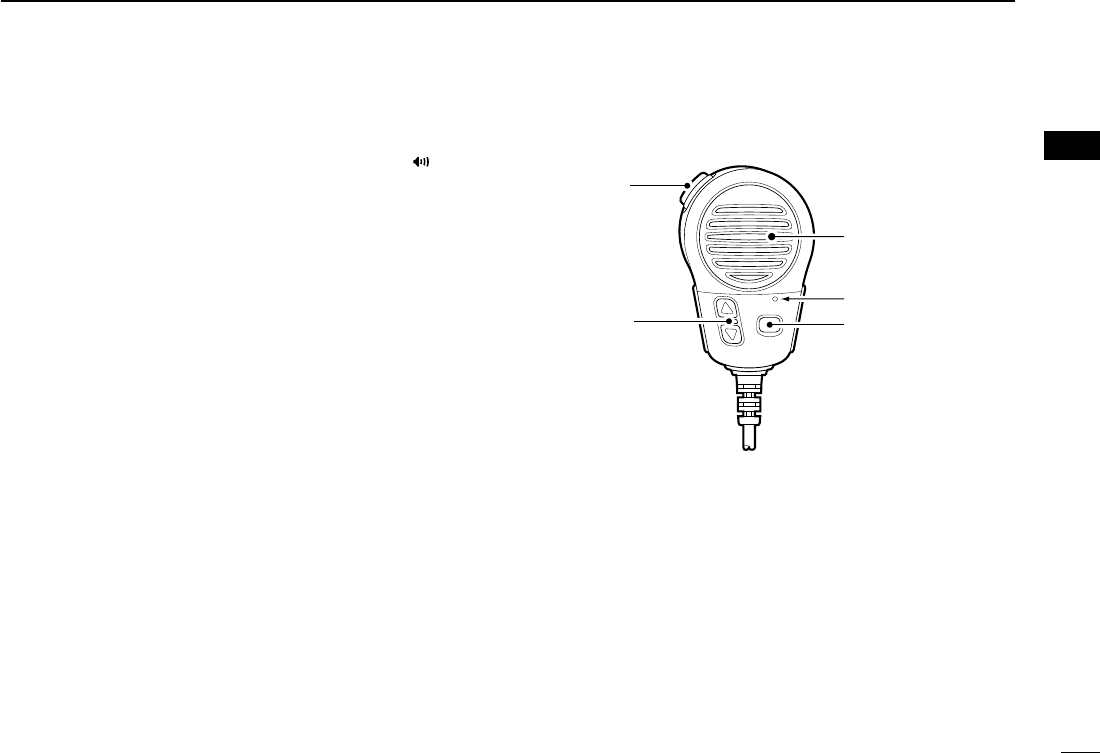
3
2
PANEL DESCRIPTION
New2001
iPUBLIC ADDRESS/RX SPEAKER KEY [PA•RX ]
➥Push to turn the public address mode ON or OFF. (p. ?)
➥Push for 1 sec. to turn the RX speaker mode ON or
OFF. (p. ?)
oSCAN KEY [SCAN•TAG](p. 10)
➥Push to start and stop normal or priority scan.
➥Push for 1 sec. to set or clear the displayed channel as
a tag (scanned) channel.
➥While pushing [HI/LO] on the microphone, push for 3
sec. to clear or set all tag channels in the selected chan-
nel group.
!0 CHANNEL UP/DOWN KEYS [YY]/[ZZ]•[U/I/C]
➥Push to select the operating channels, set mode set-
tings, etc. (pgs. 5, 6, 34)
➥Push and hold [Y]to increment the operating channel
continuously.
➥Push and hold [Z]to decrement the operating channel
continuously.
➥While pushing [SCAN•TAG], push [Y]or [Z]to adjust
the brightness of the LCD and key backlight. (p. 9)
➥Push both keys to select one of three channel groups
in sequence. (p. 6)
•International, U.S.A. and Canadian channels are available.
■Microphone
qPTT SWITCH [PTT]
Push and hold to transmit; release to receive. (p. 7)
wCHANNEL UP/DOWN KEYS [YY]/[ZZ]
Push either key to change the operating memory channel,
Set mode settings, etc. (pgs. 5, 6, 34)
eTRANSMIT POWER KEY [HI/LO]
➥Toggles power high and lower when pushed. (p. 7)
•Some channels are set to low power only.
➥While pushing [HI/LO], turn power ON to toggle the mi-
crophone lock function ON and OFF. (p. 9)
Speaker
Microphone
w
q
e
2
!IC-M422_FCC.qxd 05.1.14 11:30 AM Page 3 (1,1)
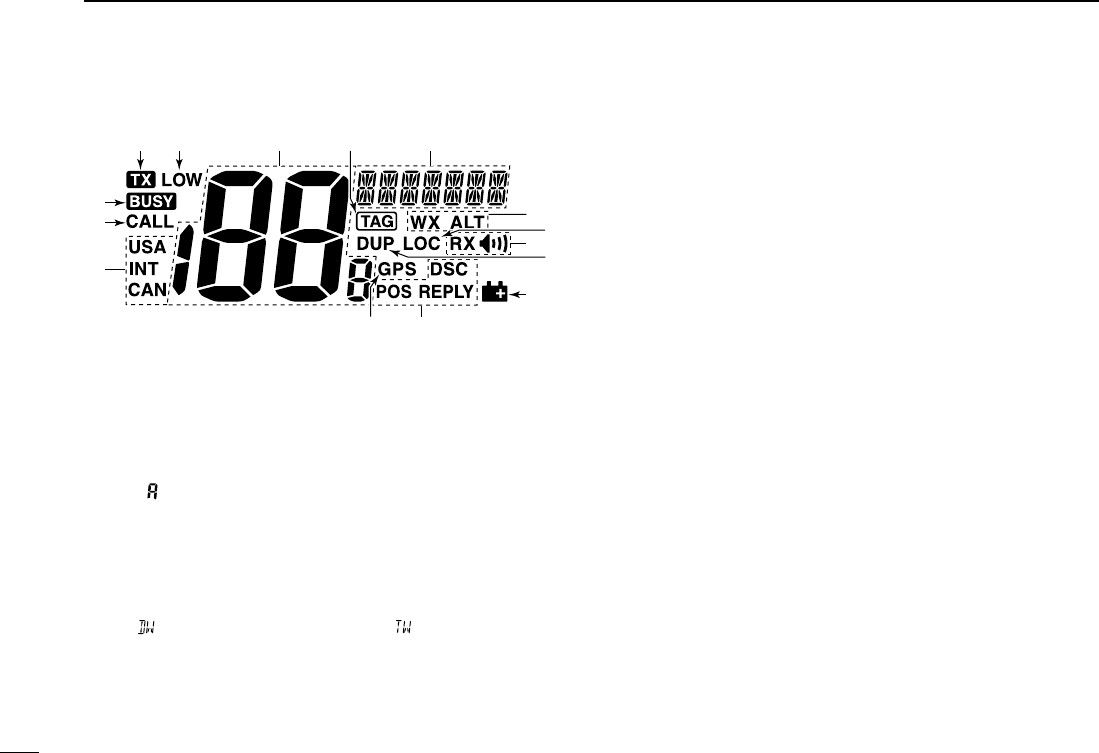
4
2PANEL DESCRIPTION
New2001
■Function display
qTRANSMIT INDICATOR (p. 7)
Appears while transmitting.
wLOW POWER INDICATOR (p. 7)
Appears when low power is selected.
eCHANNEL NUMBER READOUT
➥Indicates the selected operating channel number.
• “” appears when a simplex channel is selected. (p. 6)
➥In set mode, indicates the selected condition. (p. 31)
rTAG CHANNEL INDICATOR (p. 11)
Appears when a tag channel is selected.
tCHANNEL COMMENT INDICATOR
➥Channel comment appears if programmed. (p. 9)
➥“” blinks during dualwatch; “” blinks during tri-
watch. (p. 12)
yWEATHER CHANNEL INDICATOR (pgs. 6, 32)
➥“WX” appears when a weather channel is selected.
➥“WX ALT” appears when the weather alert function is in
use; blinks when an alert tone is received.
uLOCAL INDICATOR (p. 7)
Appears when the attenuator function is turned ON.
iRX SPEAKER INDICATOR (p. ?)
Appears during the RX speaker mode.
oDUPLEX INDICATOR (p. 6)
Appears when a duplex channel is selected.
!0 LOW BATTERY INDICATOR
Appears when the battery voltage drops to approx. 10 V
DC or below.
!1 DSC INDICATOR
Indicates the DSC status.
➥“DSC” appears when a DSC call is received. (p. 25, 26)
➥“POS REPLY” appears when a position request reply
call or position report reply call is received. (p. 28)
!2 GPS INDICATOR
➥Appears while valid position data is received.
➥Blinks when invalid position data is received.
➥Disappears when no GPS receiver is connected.
!3 CHANNEL GROUP INDICATOR (p. 6)
Indicates whether a U.S.A. “USA,” International “INT” or
Canadian “CAN” channel is in use.
!4 CALL CHANNEL INDICATOR (p. 5)
Appears when the call channel is selected.
!5 BUSY INDICATOR (p. 7)
Appears when receiving a signal or when the squelch
opens.
qw e r t
!0
y
i
!1!2
!5
!4
!3
u
o
!IC-M422_FCC.qxd 05.1.14 11:30 AM Page 4 (1,1)
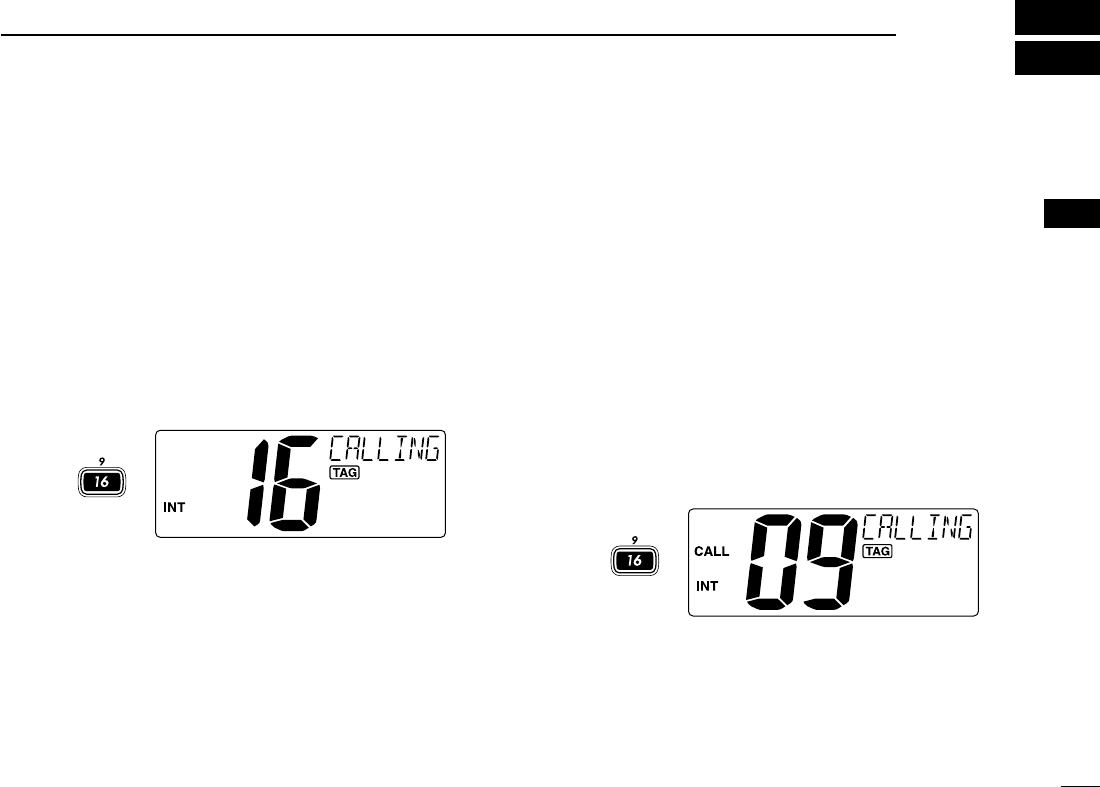
5
3
BASIC OPERATION
3
■Channel selection
ïïChannel 16
Channel 16 is the distress and safety channel. It is used for
establishing initial contact with another station and for emer-
gency communications. Channel 16 is monitored during both
dualwatch and tri-watch. While standing by, you must monitor
Channel 16.
➥Push [16•9]momentarily to select Channel 16.
➥Push [CH/WX•DUAL]to return to the condition before select-
ing Channel 16, or push [Y]or [Z]to select operating chan-
nel.
ïïChannel 9 (Call channel)
Each regular channel group has a separate leisure-use call
channel. The call channel is monitored during tri-watch. The
call channels can be programmed (p. 8) and are used to store
your most often used channels in each channel group for
quick recall.
➥Push [16•9]for 1 sec. to select the call channel of the se-
lected channel group.
•“CALL” and call channel number appear.
•Each channel group may have an independent call channel after
programming a call channel. (p. 8)
➥Push [CH/WX•DUAL]to return to the condition before se-
lecting call channel, or push [Y]or [Z]to select an oper-
ating channel.
Push
for 1 sec.
Push
!IC-M422_FCC.qxd 05.1.14 11:30 AM Page 5 (1,1)
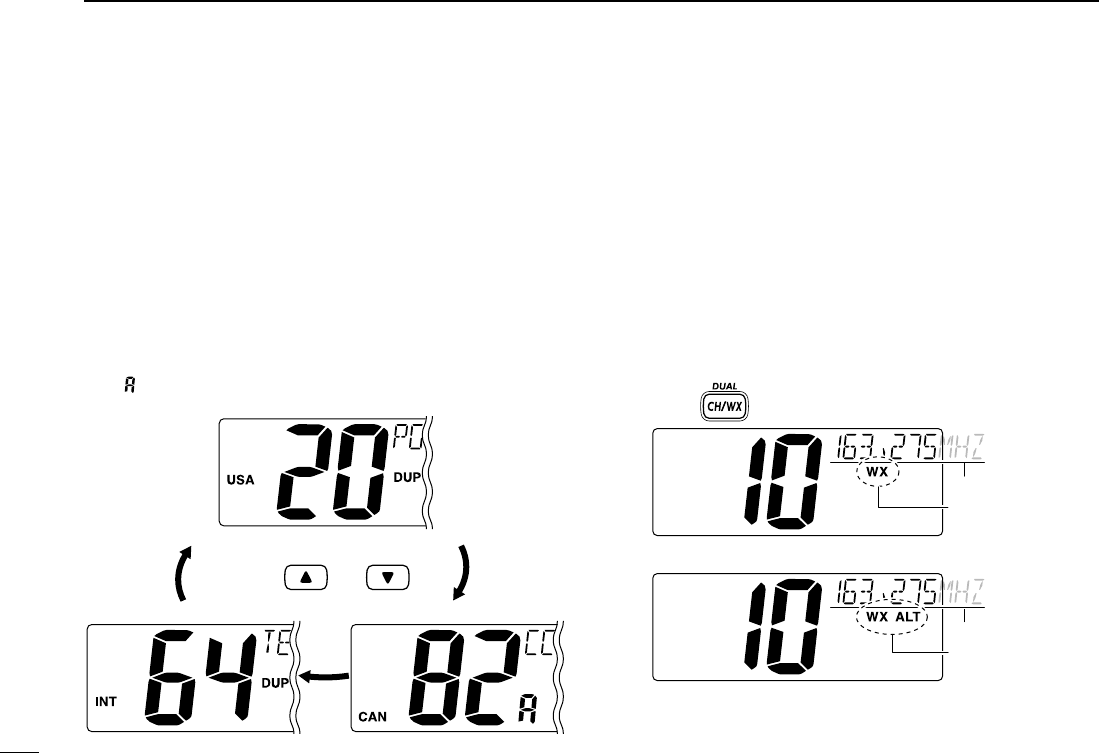
6
3BASIC OPERATION
New2001
ïïU.S.A.,Canadian and international channels
The IC-M422 are pre-programmed with 57 U.S.A., 61 Cana-
dian and 57 international channels. These channel groups
may be specified for the operating area.
qPush [CH/WX•DUAL]to select a regular channel.
•If a weather channel appears, push [CH/WX•DUAL]again.
wPush both [Y]and [Z]on the transceiver to change the
channel group, if necessary.
•U.S.A., International and Canadian channels can be selected in
sequence.
ePush [Y]or [Z]to select a channel.
•“DUP” appears for duplex channels.
•“ ” appears when a simplex channel is selected.
ïïWeather channels
The IC-M422 has 10 weather channels. These are used for
monitoring broadcasts from NOAA (National Oceanographic
and Atmospheric Administration.)
The transceiver can detect a weather alert tone on the se-
lected weather channel while receiving the channel, during
standby on a regular channel or while scanning. (p. 32)
qPush [CH/WX•DUAL]once or twice to select a weather
channel.
•“WX” appears when a weather channel is selected.
• “WX ALT” appears when the Weather alert function is in use.
(p. 32)
wPush [Y]or [Z]to select a channel.
Scrolls
Appears
Scrolls
Appears
When Weather alert is OFF.
When Weather alert is ON.
Push once or twice
Push and
!IC-M422_FCC.qxd 05.1.14 11:30 AM Page 6 (1,1)
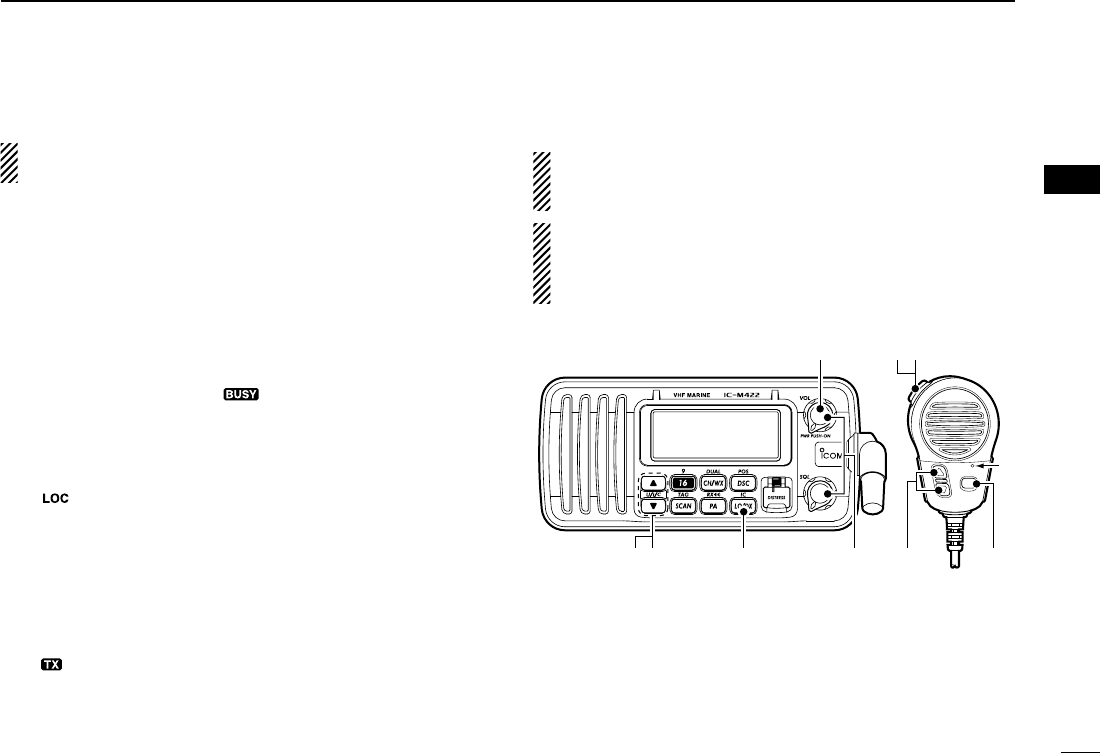
7
3
BASIC OPERATION
New2001
3
■Receiving and transmitting
CAUTION: Transmitting without an antenna may dam-
age the transceiver.
qPush [VOL] for 1 sec. to turn power ON.
wSet the audio and squelch levels.
➥Rotate [SQL] fully counterclockwise in advance.
➥Rotate [VOL] to adjust the audio output level.
➥Rotate [SQL] clockwise until the noise disappears.
eTo change the channel group, push both [Y]and [Z]on
the transceiver. (p. 6)
rPush [Y]or [Z]to select the desired channel. (p. 6)
•When receiving a signal, “” appears and audio is emitted
from the speaker.
•Further adjustment of [VOL] may be necessary.
tPush [LO/DX•IC]to turn the receive attenuator function
ON or OFF, if necessary.
•“ ” appears when the receive attenuator function is in use.
yPush [HI/LO] to select the output power if necessary.
•“LOW” appears when low power is selected.
•Choose low power for short range communications, choose high
power for longer distance communications.
•Some channels are for low power only.
uPush and hold [PTT] to transmit, then speak into the mi-
crophone (M).
•“ ” appears.
•Channel 70 cannot be used for transmission other than DSC.
iRelease [PTT] to receive.
Simplex channels, 3, 21, 23, 61, 64, 81, 82 and 83 CAN-
NOT be lawfully used by the general public in U.S.A. wa-
ters.
IMPORTANT: To maximize the readability of your trans-
mitted signal, pause a few sec. after pushing [PTT], hold
the microphone 2 to 4 inches (5 to 10 cm) from your mouth
and speak into the microphone (M) at a normal voice level.
i
ry
M
u
q
M: Microphone
w
rte
!IC-M422_FCC.qxd 05.1.14 11:30 AM Page 7 (1,1)
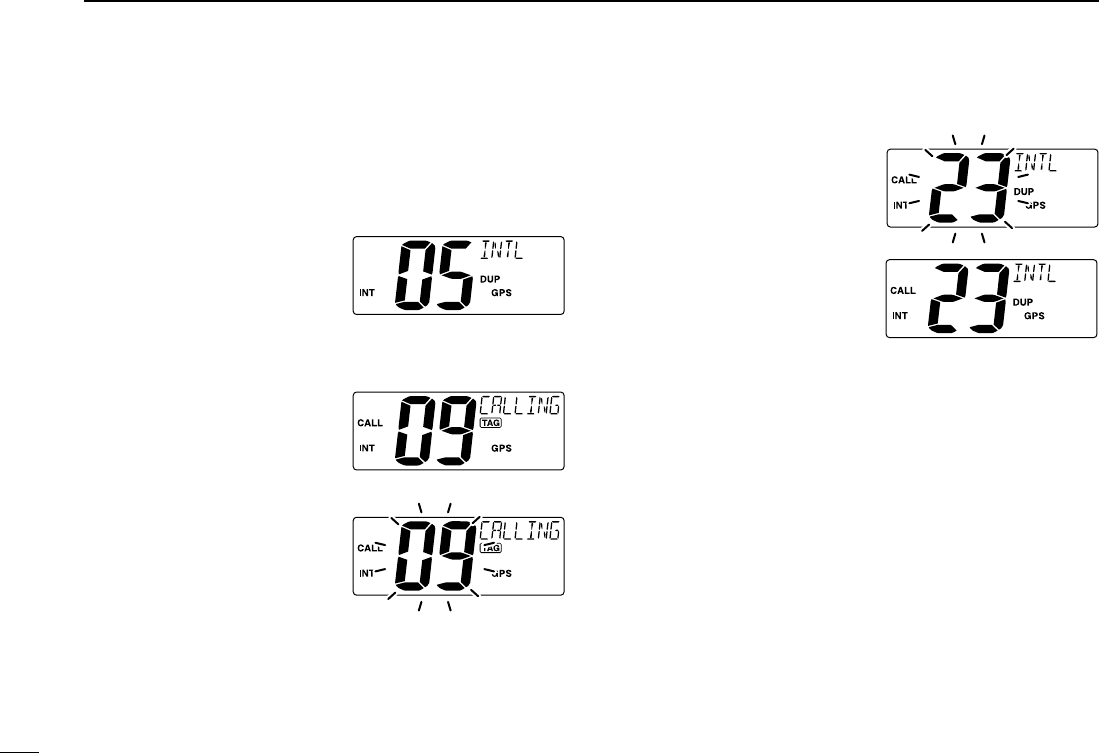
8
3BASIC OPERATION
New2001
■Call channel programming
Call channel is used to select Channel 9 (default), however,
you can program the call channel with your most often-used
channels in each channel group for quick recall.
qPush both [Y]and [Z]on
the transceiver one or more
times to select the desired
channel group (U.S.A., In-
ternational or Canada) to be
programmed.
wPush [16•9]for 1 sec. to se-
lect the call channel of the
selected channel group.
•“CALL” and call channel num-
ber appear.
ePush [16•9]again for 3 sec.
(until a long beep changes
to 2 short beeps) to enter
call channel programming
condition.
•Channel number starts blink-
ing.
rPush [Y]or [Z]to select
the desired channel.
tPush [16•9]to program the
displayed channel as the
call channel.
•Push [CH/WX•DUAL]to can-
cel.
•The channel number stops
blinking.
!IC-M422_FCC.qxd 05.1.14 11:30 AM Page 8 (1,1)
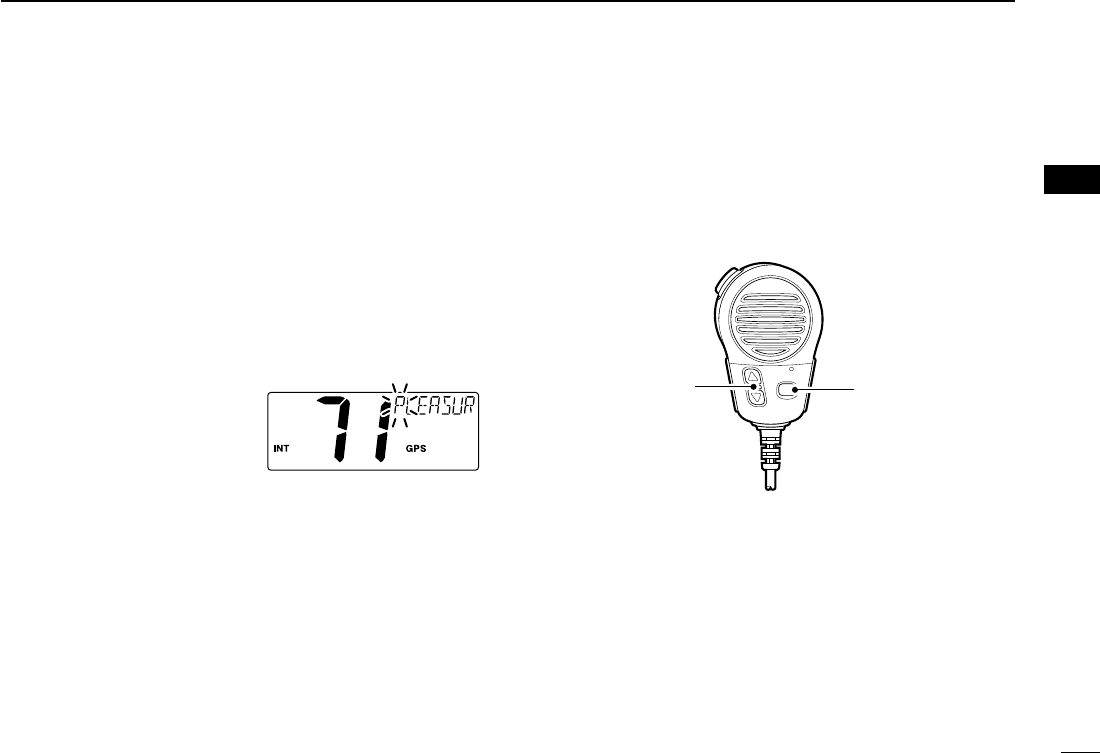
9
3
BASIC OPERATION
New2001
3
■Channel comments
Memory channels can be labeled with alphanumeric com-
ments of up to 10 characters each for easy channel recogni-
tion.
More than 7 characters comment scrolls automatically at the
channel comment indicator after the channel selection.
Capital letters, small letters (except f, j, k, p, s, v, x, z), 0 to 9,
some symbols (– . /) and space can be used.
qSelect the desired channel.
•Cancel dualwatch, tri-watch or scan in advance.
wWhile pushing [CH/WX•
DUAL], push [16•9]to edit
the channel comment.
•A cursor and the first char-
acter start blinking alter-
nately.
eSelect the desired charac-
ter by pushing [Y]or [Z].
• Push [CH/WX•DUAL]or [16•9]to move the cursor forward or
backward, respectively.
rRepeat step eto input all characters.
tPush [DSC•POS]to input and set the comment.
•Push [LO/DX•IC]to cancel.
•A cursor and the character stop blinking.
yRepeat steps qto tto program other channel com-
ments, if desired.
■Microphone lock function
The microphone lock function electrically locks [Y]/[Z]and
[HI/LO] keys on the supplied microphone. This prevents ac-
cidental channel changes and function access.
➥While pushing [HI/LO] on the microphone, turn power ON
to toggle the lock function ON and OFF.
■Display backlighting
The function display and keys can be backlit for better visibil-
ity under low light conditions.
➥While pushing [SCAN•TAG], push [Y]or [Z]to adjust the
brightness of the LCD and key backlight.
•The backlight is selectable in 7 levels and OFF.
[HI/LO]
[Y]/[Z]
!IC-M422_FCC.qxd 05.1.14 11:30 AM Page 9 (1,1)
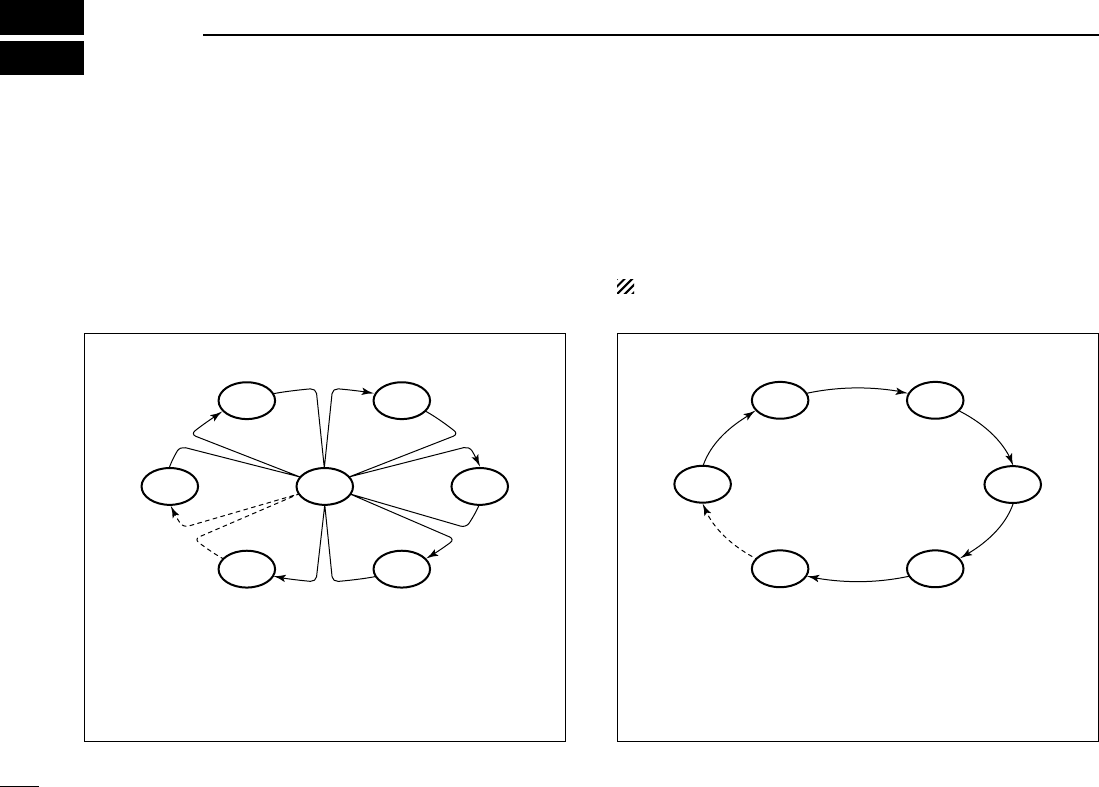
10
SCAN OPERATION
New2001
4
■Scan types
Scanning is an efficient way to locate signals quickly over a
wide frequency range. The transceiver has priority scan and
normal scan.
When the weather alert function is turned ON, the previously
selected (used) weather channel is also checked while scan-
ning. (p. 32)
Set the tag channels (scanned channel) before scanning.
Clear the tag channels which inconveniently stop scanning,
such as those for digital communication use. (Refer to right
page for details.)
Choose priority or normal scan in set mode. (p. 31)
PRIORITY SCAN
Priority scan searches through all tag channels in sequence
while monitoring Channel 16. When a signal is detected on
Channel 16, scan pauses until the signal disappears; when
a signal is detected on a channel other than Channel 16,
scan becomes dualwatch until the signal disappears.
CH 06
CH 01
CH 16
CH 02
CH 05 CH 04
CH 03
NORMAL SCAN
Normal scan, like priority scan, searches through all tag
channels in sequence. However, unlike priority scan, Chan-
nel 16 is not checked unless Channel 16 is set as a tag
channel.
CH 01 CH 02
CH 06
CH 05 CH 04
CH 03
!IC-M422_FCC.qxd 05.1.14 11:30 AM Page 10 (1,1)
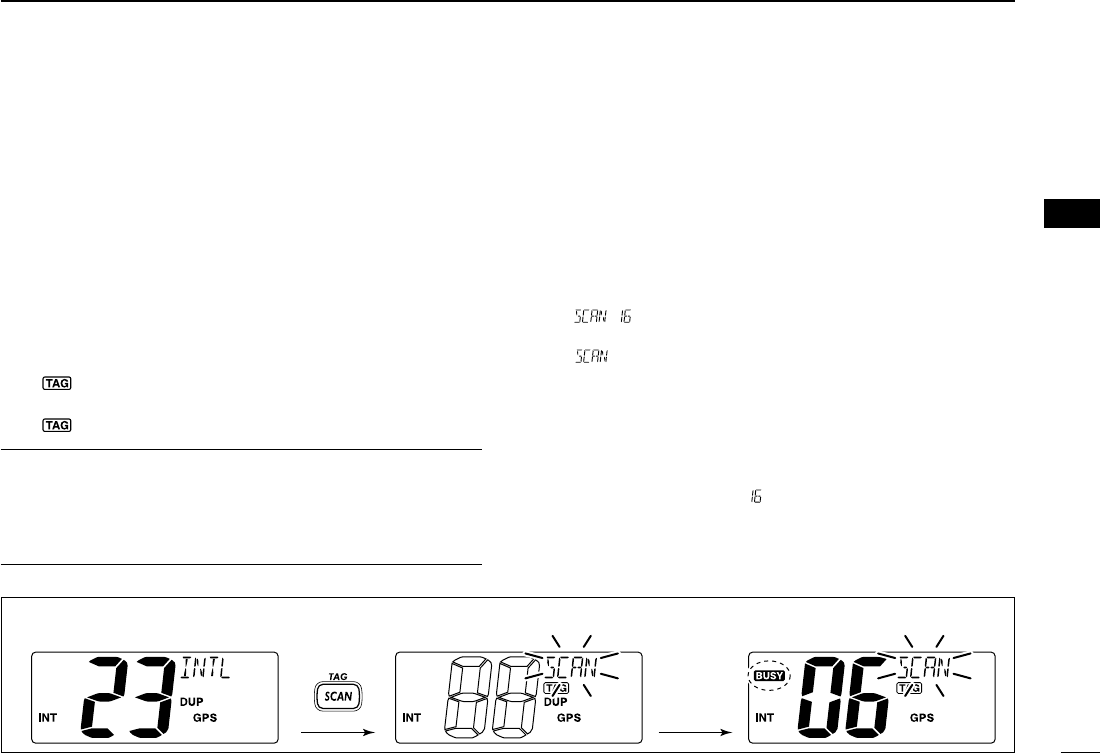
11
4
SCAN OPERATION
New2001
4
■Setting tag channels
For more efficient scanning, add the desired channels as tag
channels or clear the tag for unwanted channels.
Channels are not tagged will be skipped during scanning. Tag
channels can be assigned to each channel group (USA, INT,
CAN) independently.
qPush both [Y]and [Z]to select the desired channel group
(USA, INT or CAN.)
wSelect the desired channel to be set as a tag channel.
ePush [SCAN•TAG]for 1 sec. to set the displayed channel
as a tag channel.
•“ ” appears in the display.
rTo cancel the tag channel setting, repeat step e.
•“ ” disappears.
✔Clearing (or setting) all tagged channels
While pushing [HI/LO] on the microphone, push [SCAN•TAG]
for 3 sec. (until a long beep changes to 2 short beeps) to clear
all tag channels in the channel group.
• Repeat above procedure to set all tag channels.
■Starting a scan
Set scan type (priority or normal scan) and scan resume timer
in advance, using set mode. (p. 31)
qPush both [Y]and [Z]to select the desired channel group
(USA, INT, CAN) if desired.
wSet tag channels as described at left.
eMake sure the squelch is closed to start a scan.
rPush [SCAN•TAG]to start priority or normal scan.
•“ ” appears at the channel comment indicator during pri-
ority scan.
•“ ” appears at the channel comment indicator during normal
scan.
•When a signal is detected, scan pauses until the signal disap-
pears or resumes after pausing 5 sec. according to set mode
setting. (Channel 16 is still monitored during priority scan.)
•Push [Y]or [Z]to check the scanning tag channels, to change
the scanning direction or resume the scan manually.
•A beep tone sounds and “” blinks at the channel comment in-
dicator when a signal is received on Channel 16 during priority
scan.
tTo stop the scan, repeat step r.
[Example]: Starting a normal scan.
Push
Scan starts.
When a signal is
received.
!IC-M422_FCC.qxd 05.1.14 11:30 AM Page 11 (1,1)
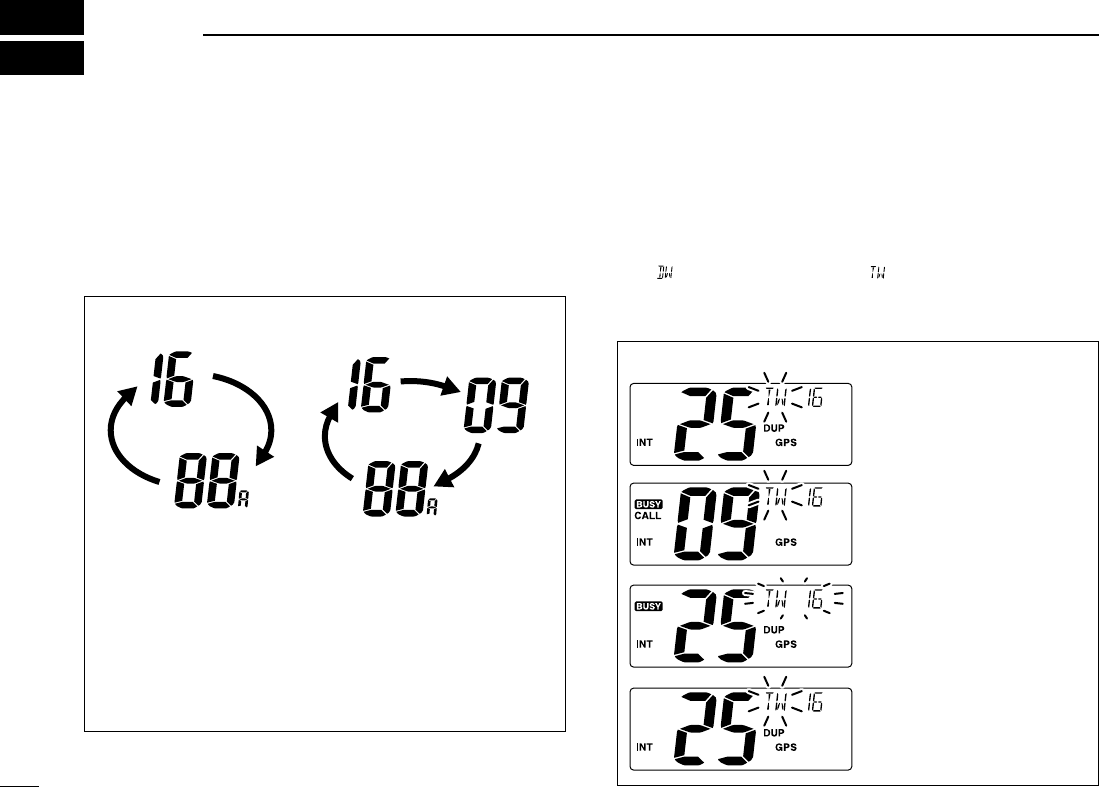
12
DUALWATCH/TRI-WATCH
New2001
5
■Description
Dualwatch monitors Channel 16 while you are receiving
another channel; tri-watch monitors Channel 16 and the call
channel while receiving another channel. Dualwatch/tri-watch
is convenient for monitor Channel 16 when you are operating
on another channel.
■Operation
qSelect dualwatch or tri-watch in set mode. (p. 32)
wPush [Y]or [Z]to select the desired operating channel.
ePush [CH/WX•DUAL]for 1 sec. to start dualwatch or tri-
watch.
•“ ” blinks during dualwatch; “” blinks during tri-watch.
•A beep tone sounds when a signal is received on Channel 16.
rTo cancel dualwatch/tri-watch, push [CH/WX•DUAL]again.
DUALWATCH/TRI-WATCH SIMULATION
•If a signal is received on Channel 16, dualwatch/tri-watch
pauses on Channel 16 until the signal disappears.
•If a signal is received on the call channel during tri-watch,
tri-watch becomes dualwatch until the signal disappears.
•To transmit on the selected channel during dualwatch/tri-
watch, push and hold [PTT].
Dualwatch Tri-watch
Call channel
[Example]: Operating tri-watch on INT Channel 25
Tri-watch starts.
Signal is received on call
channel.
Signal is received on
Channel 16 takes priority.
Tri-watch resumes after
the signal disappears.
!IC-M422_FCC.qxd 05.1.14 11:30 AM Page 12 (1,1)
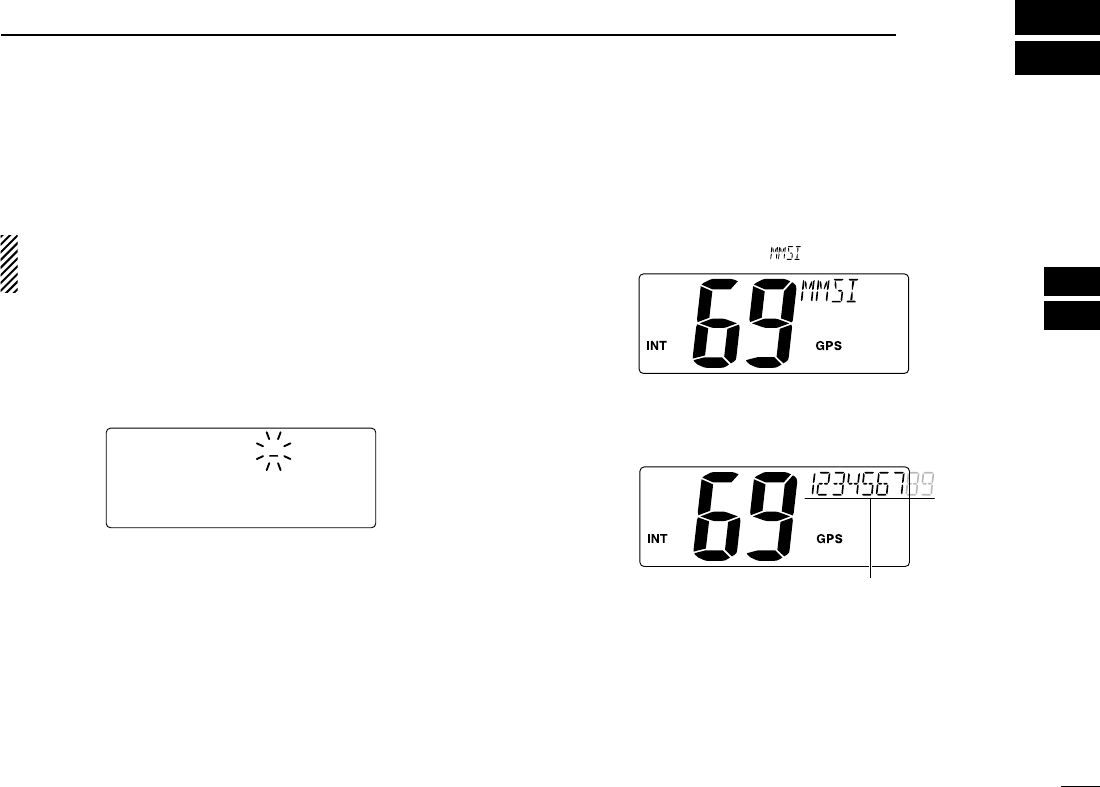
13
6
DSC OPERATION
5
6
■MMSI code programming
The 9-digit MMSI (Maritime Mobile Service Identity: DSC self
ID) code can be programmed at power ON.
This function is not available when the MMSI code has
been programmed by the dealer. This code programming
can be performed only twice.
qTurn power OFF.
wWhile pushing [DSC•POS], turn power ON to enter MMSI
code programming condition.
eAfter the display appears, release [DSC•POS].
•A cursor starts blinking.
rEdit the specified MMSI code by pushing [Y]or [Z].
• Push [CH/WX•DUAL]or [16•9]to move the cursor forward or
backward, respectively.
tInput 9-digit code, then push [DSC•POS]to set the code.
•Returns to the normal operation.
■MMSI code check
The 9-digit MMSI (DSC self ID) code can be checked.
qPush [DSC•POS]to enter the DSC menu.
wPush [Y]or [Z]to select “” and push [DSC•POS].
eCheck the 9-digit MMSI (DSC self ID) code.
• The MMSI code is displayed and scrolls at the channel comment
indicator.
rPush [DSC•POS]to exit the DSC menu.
MMSI (DSC self ID) code scrolls
!IC-M422_FCC.qxd 05.1.14 11:30 AM Page 13 (1,1)
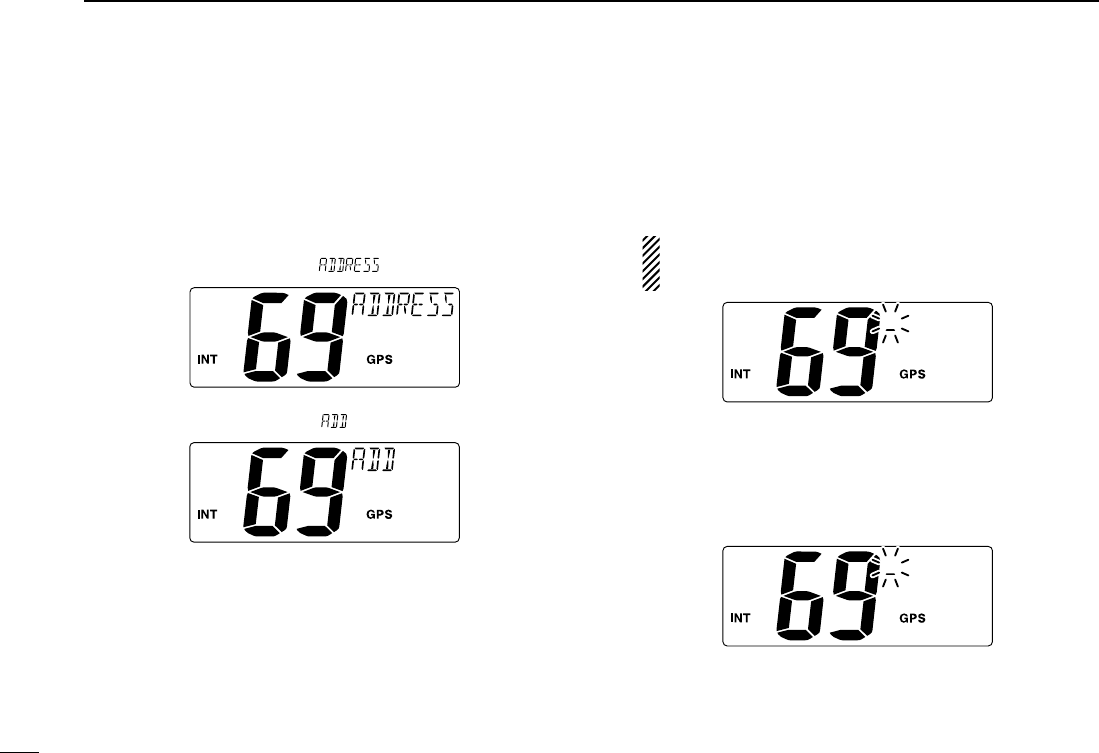
14
6DSC OPERATION
New2001
■DSC individual ID
A total of 100 DSC address IDs (9-digit) can be programmed
and named with up to 7 characters.
DProgramming Address ID/Group ID
qPush [DSC•POS]to enter the DSC menu.
wPush [Y]or [Z]to select “,” push [DSC•POS].
ePush [Y]or [Z]to select “,” push [DSC•POS].
rPush [Y]or [Z]to set the 9-digit individual/group ID.
•Push [CH/WX•DUAL]or [16•9]to move the cursor forward or
backward, respectively.
•Push [LO/DX•IC]to cancel and exit the condition.
1st digit ‘0’is fixed for a group ID. When you input 1st digit ‘0’
and other 8 digits, the ID is automatically registered as a group
ID.
tAfter input the 9-digit code, push [DSC•POS]to set up to a
5-character ID name using [Y]or [Z].
•Push [CH/WX•DUAL]or [16•9]to move the cursor forward or
backward, respectively.
•Push [LO/DX•IC]to cancel and exit the condition.
yPush [DSC•POS]to program and exit the DSC menu.
!IC-M422_FCC.qxd 05.1.14 11:30 AM Page 14 (1,1)
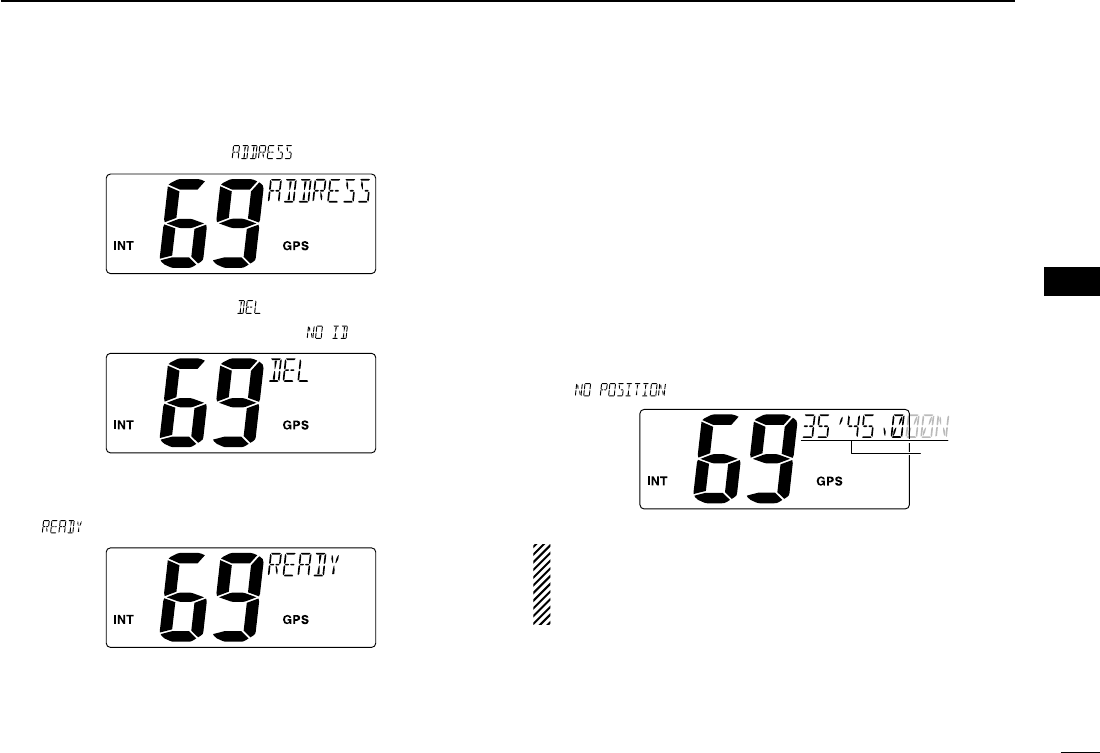
15
6
DSC OPERATION
New2001
6
DDeleting Address ID/Group ID
qPush [DSC•POS]to enter the DSC menu.
wPush [Y]or [Z]to select “,” and push [DSC•POS].
ePush [Y]or [Z]to select “”, push [DSC•POS].
•When no address ID is programmed, “” is displayed.
rPush [Y]or [Z]to select the desired ID name for deleting
and push [DSC•POS].
• “” appears.
tPush [DSC•POS]to delete the address ID and exit the
DSC menu.
■Position indication
When a GPS receiver (NMEA0183 ver. 2.0 or 3.01) is con-
nected, the transceiver displays the current position data in
seconds of accuracy.
A NMEA0183 ver. 2.0 or 3.01 (sentence formatters RMC,
GGA, GNS, GLL) compatible GPS receiver is required. Ask
your dealer about suitable GPS receivers.
➥Push [DSC•POS]for 1 sec. to display the current position.
•‘Latitude’and ‘Longitude’scroll in sequence at the channel com-
ment indicator.
• “” scrolls when no GPS is connected.
• When the connecting GPS receiver is compatible with
several sentence formatters, the order of input prece-
dence is ‘RMC,’‘GGA,’‘GNS’and ‘GLL.’
• “GPS” blinks when the GPS data is invalid.
Scrolls
!IC-M422_FCC.qxd 05.1.14 11:30 AM Page 15 (1,1)
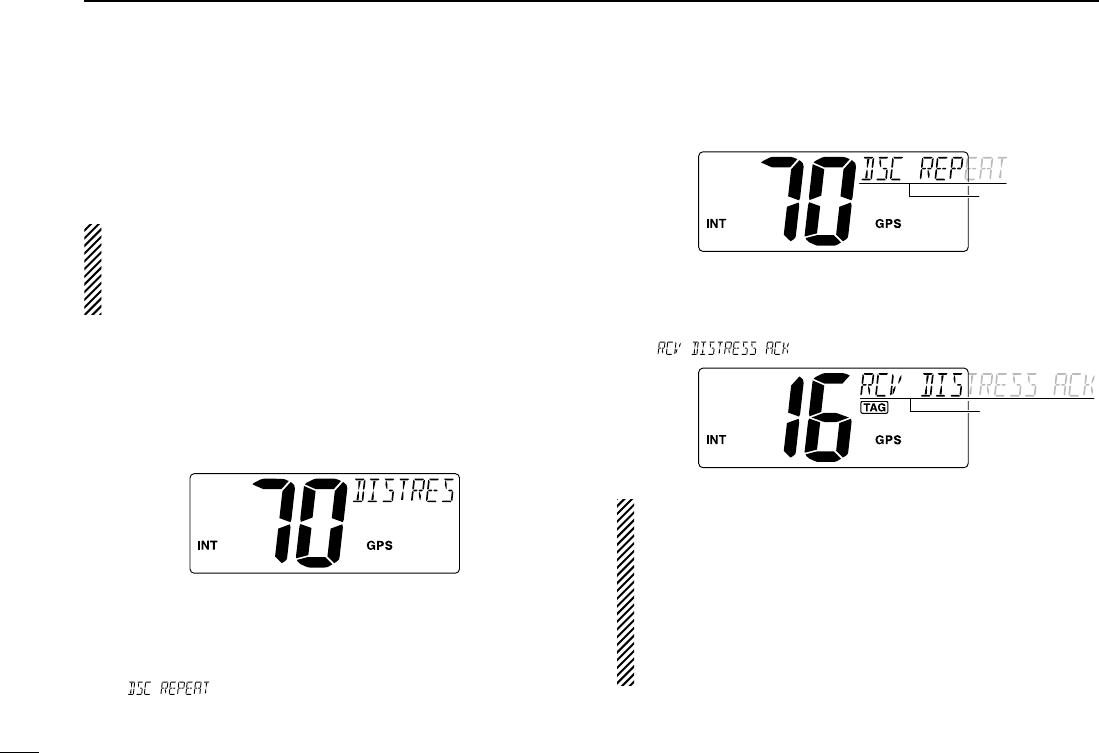
16
6DSC OPERATION
New2001
■Distress call
A distress call should be transmitted, if in the opinion of the
Master, the ship or a person is in distress and requires imme-
diate assistance.
NEVER USE THE DISTRESS CALL WHEN YOUR
SHIP OR A PERSON IS NOT IN AN EMERGENCY.
A DISTRESS CALL CAN BE USED ONLY WHEN
IMMEDIATE HELP IS NEEDED.
qConfirm no distress call is being received.
wWhile lifting up the key cover, push [DISTRESS] for 5 sec.
to transmit the distress call.
•Emergency channel (Ch 70) is automatically selected and the
distress call is transmitted.
• While pushing [DISTRESS], the key backlighting is blinking.
eAfter transmitting the distress call, the transceiver waits for
an acknowledgment call on Ch70.
•The distress call is automatically transmitted every 3.5 to 4.5
minutes.
•“ ” scrolls at the channel comment indicator.
rAfter receiving the acknowledgment, reply using the mi-
crophone.
•Channel 16 is automatically selected.
•“ ” scrolls at the channel comment indicator.
➥A distress alert contains;
• Kinds of distress: Undesignated distress
•Position data : Latest GPS position data held for 23.5 hrs.
or until the power is turned OFF.
➥The distress call is repeated every 3.5–4.5 min., until re-
ceiving an ‘acknowledgement.’
➥Push [DISTRESS] to transmit a renewed Distress call,
if desired.
➥Push [16•9]to cancel the ‘Call repeat’mode.
Scrolls
Scrolls
!IC-M422_FCC.qxd 05.1.14 11:30 AM Page 16 (1,1)
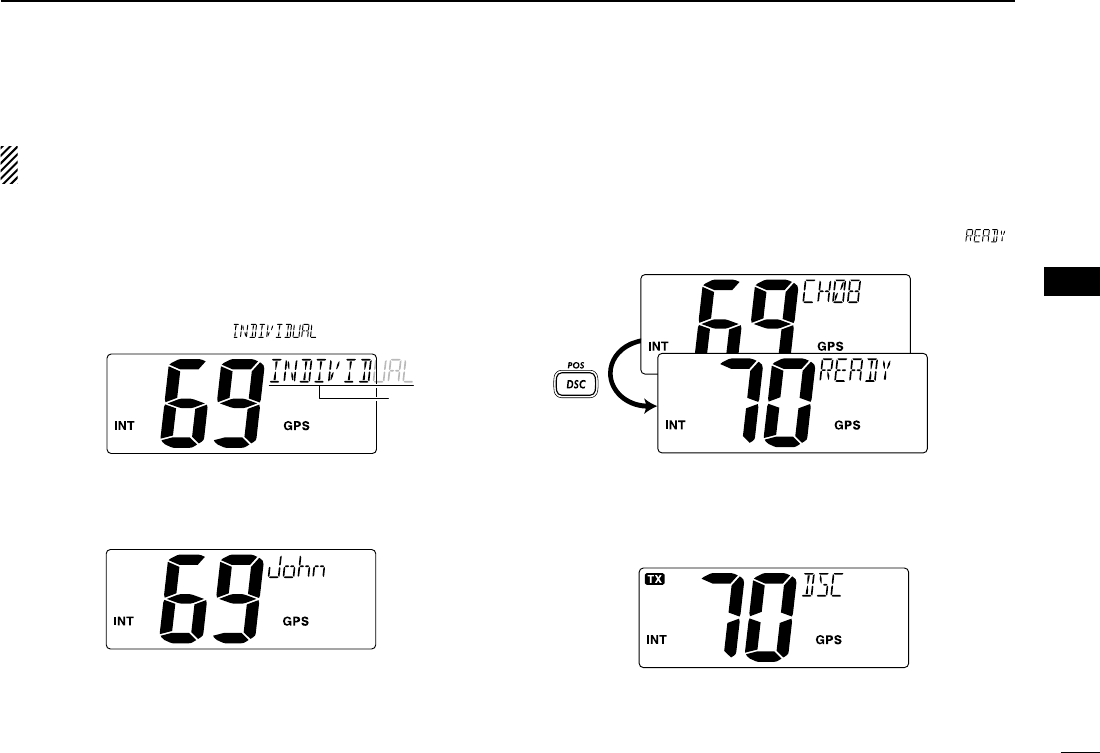
17
6
DSC OPERATION
New2001
6
■Transmitting DSC calls
To ensure correct operation of the DSC function, please
make sure you set the squelch correctly. (P. 7)
DTransmitting an individual call
The individual call function allows you to transmit a DSC sig-
nal to a specific ship only.
qPush [DSC•POS]to enter the DSC menu.
wPush [Y]or [Z]to select “,” push [DSC•POS].
wPush [Y]or [Z]to select the desired pre-programmed in-
dividual address, push [DSC•POS].
• The ID code must be set in advance. (p. 14)
ePush [Y]or [Z] to select the desired intership channel,
push [DSC•POS].
• Intership channels are already preset into the transceiver in rec-
ommending order.
• After pushing [DSC•POS], Channel 70 is selected and “”
appears at the channel comment indicator.
rPush [DSC•POS]to transmit the individual call.
•If Channel 70 is busy, the transceiver stands by until the channel
becomes clear.
•Routine category only is available.
Transmitting
Push
Scrolls
!IC-M422_FCC.qxd 05.1.14 11:30 AM Page 17 (1,1)
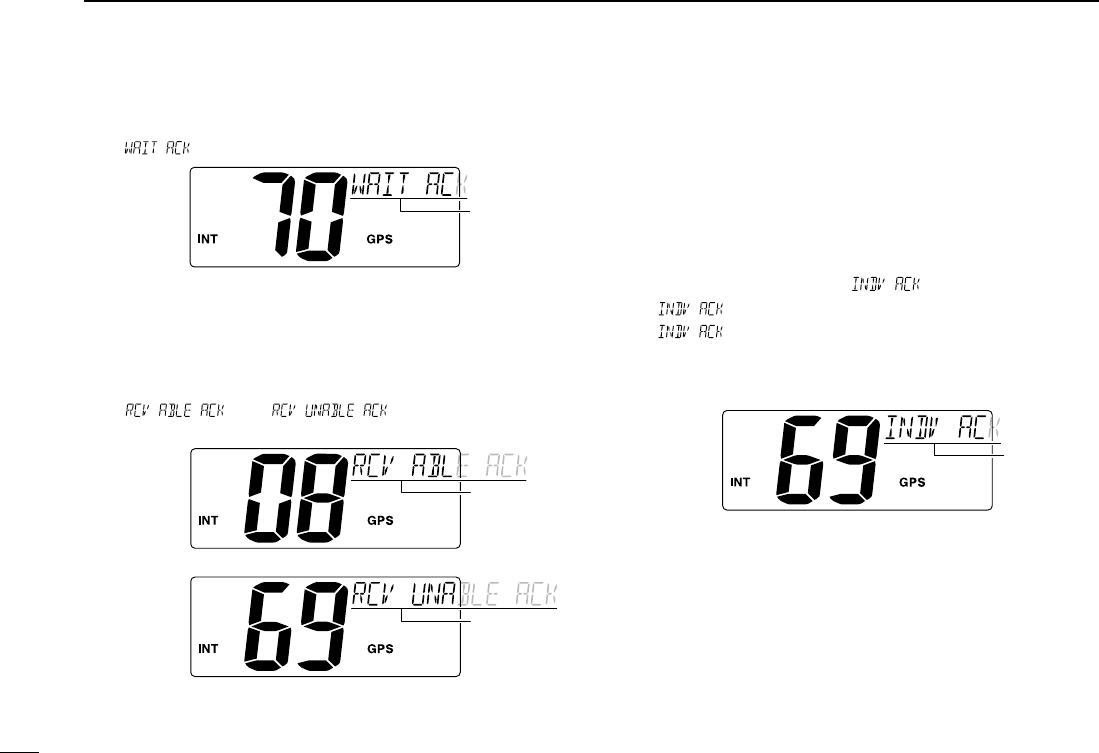
18
6DSC OPERATION
New2001
tStands by on Channel 70 until an acknowledgement is re-
ceived.
•“ ” scrolls at the channel comment indicator.
yWhen the acknowledgement ‘Able to comply’is received,
the specified channel (in step e) is selected with beeps
automatically. Or, when the acknowledgement ‘Unable to
comply’is received, the display returns to the operated
channel (before enter the DSC menu) with beeps.
•“ ” or “” scrolls at the channel
comment indicator.
uPush any key to stop the beep, then push and hold [PTT]
to communicate your message to the responding ship.
DTransmitting an individual acknowledgement
When receiving an individual call, you can transmit an ac-
knowledgement (‘Able to comply’or ‘Unable to comply’) by
using the on screen prompts (see page 26 for details). Alter-
natively, you can send an acknowledgement through the
menu system as follows.
qPush [DSC•POS]to enter the DSC menu.
wPush [Y]or [Z] to select “,” push [DSC•POS].
• “” item appears after an individual call is received.
• “” item disappears if another call is received after the
individual call.
• The individual acknowledgement can be transmitted to the last
received individual call only.
Scrolls
‘Able to comply’ is received.
Scrolls
‘Unable to comply’ is received.
Scrolls
Scrolls
!IC-M422_FCC.qxd 05.1.14 11:30 AM Page 18 (1,1)
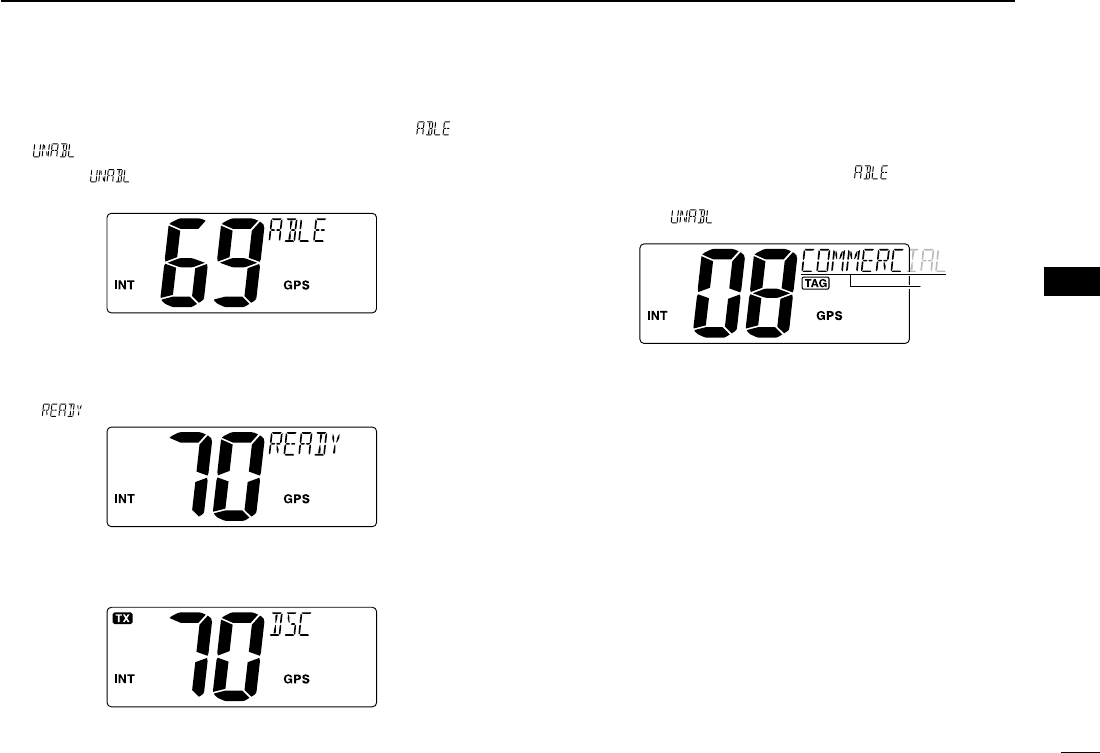
19
6
DSC OPERATION
New2001
6
ePush [Y]or [Z]to select the acknowledgement “” or
“.”
• When “” is selected, the reason “No Reason Given” will
be transmitted.
rPush [DSC•POS]to enter selected individual call acknowl-
edgement.
• “” appears at the channel comment indicator.
tPush [DSC•POS]to transmit the acknowledgement call to
the selected station.
yAfter the individual acknowledgement call has been trans-
mitted, the specified channel (specified by the calling sta-
tion) is selected automatically when “” is selected, or
returns to the previous condition (before entering the DSC
menu) when “” is selected in step e.
Scrolls
Transmitting
‘ABLE’ is selected.
!IC-M422_FCC.qxd 05.1.14 11:30 AM Page 19 (1,1)
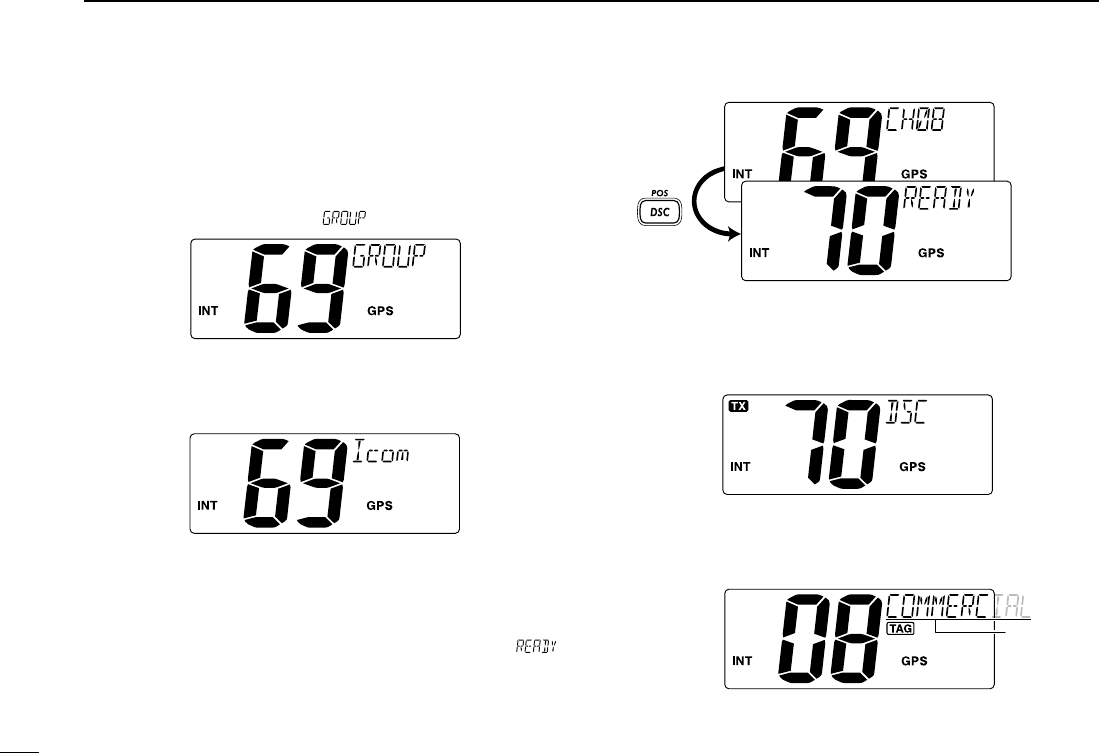
DTransmitting a group call
The group call function allows you to transmit a DSC signal to
a specific group only.
qPush [DSC•POS]to enter the DSC menu.
wPush [Y]or [Z] to select “,” push [DSC•POS].
ePush [Y]or [Z] to select the desired pre-programmed
group address, push [DSC•POS].
• The ID code must be set in advance. (p. 14)
rPush [Y]or [Z] to select the desired intership channel,
and push [DSC•POS].
• Intership channels are already preset into the transceiver in rec-
ommending order.
• After pushing [DSC•POS], Channel 70 is selected and “”
appears at the channel comment indicator.
tPush [DSC•POS]to transmit the group call.
•If Channel 70 is busy, the transceiver stands by until the channel
becomes clear.
•Routine category only is available.
yAfter the group call has been transmitted, the specified
channel (in step r) is selected automatically.
uPush and hold [PTT] to communicate your message to the
responding ship.
Scrolls
Transmitting
Push
20
6DSC OPERATION
New2001
!IC-M422_FCC.qxd 05.1.14 11:30 AM Page 20 (1,1)
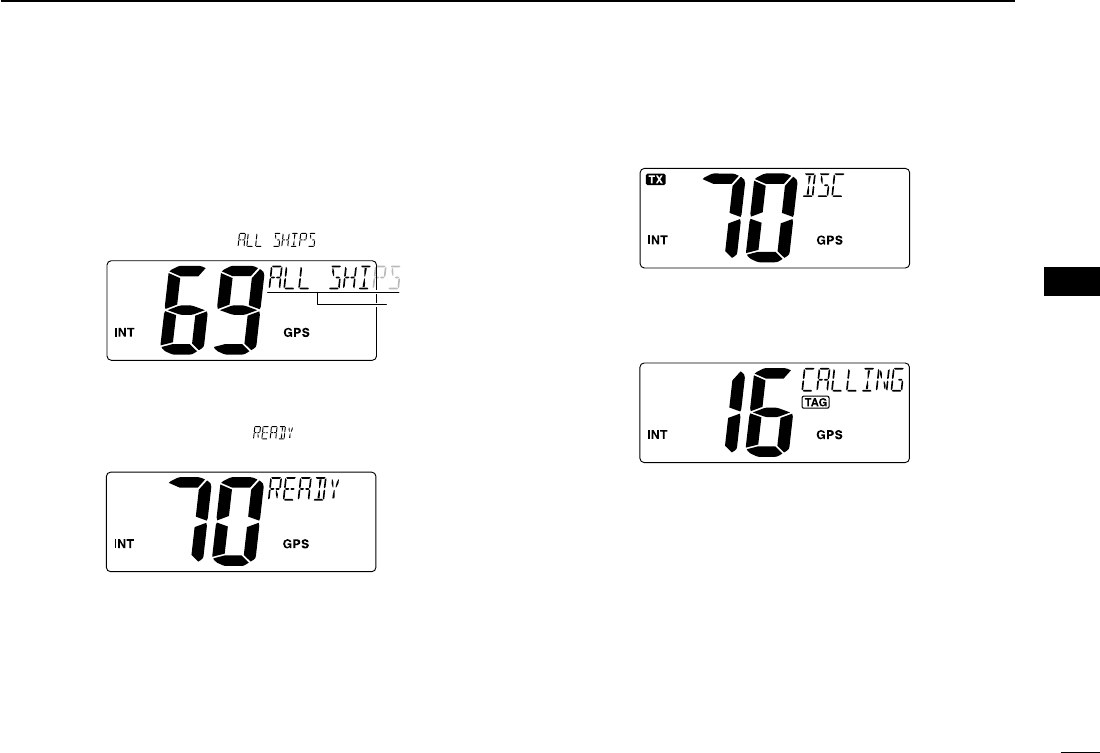
21
6
DSC OPERATION
New2001
6
DTransmitting an all ships call
Large ships use Channel 70 as their ‘listening channel.’
When you want to announce a message to these ships, use
the
‘
all ships call’function.
qPush [DSC•POS]to enter the DSC menu.
wPush [Y]or [Z]to select “.”
ePush [DSC•POS]to enter the standby condition for All
Ships call.
• Channel 70 is selected and “” appears at the channel
comment indicator.
rPush [DSC•POS]to transmit the all ships call.
• Routine category only is available.
tAfter the all ships call has been transmitted, Channel 16 is
selected automatically.
Transmitting
Scrolls
!IC-M422_FCC.qxd 05.1.14 11:30 AM Page 21 (1,1)
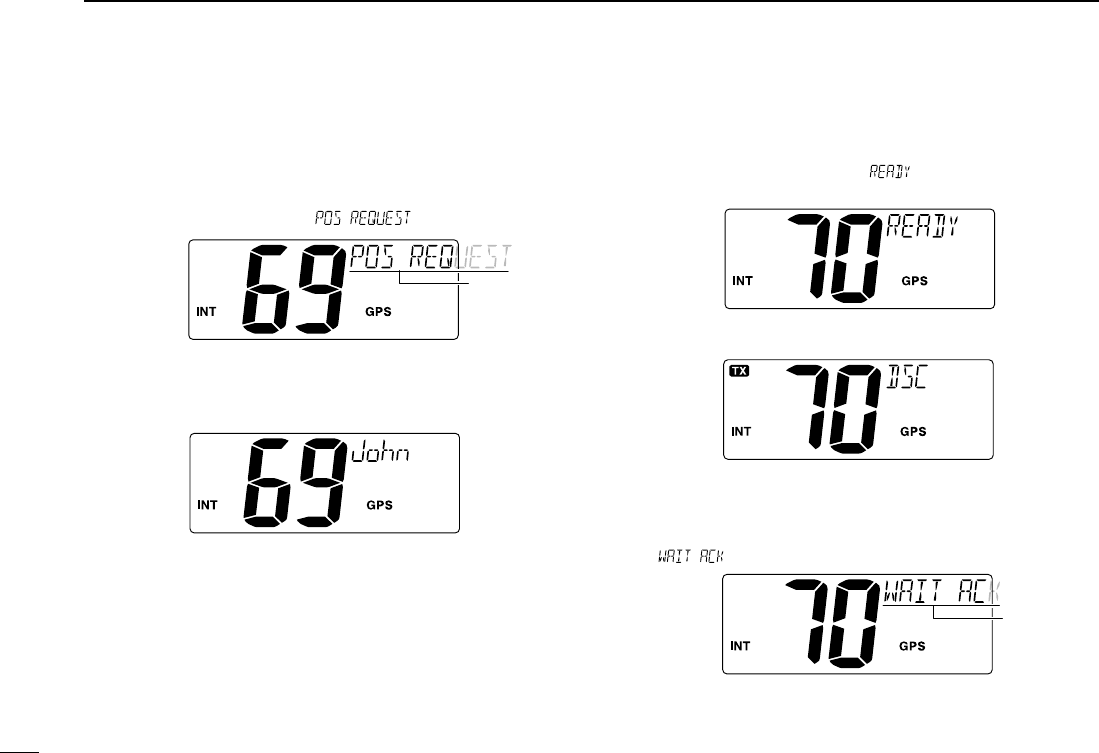
22
6DSC OPERATION
New2001
DTransmitting a position request call
Transmit a position request call when you want to know a
specified ship’s current position, etc.
qPush [DSC•POS]to enter the DSC menu.
wPush [Y]or [Z] to select “,” push [DSC•POS].
ePush [Y]or [Z] to select the desired pre-programmed in-
dividual address.
• The ID code must be set in advance. (p. 14)
rPush [DSC•POS]to enter the standby condition for posi-
tion request call.
• Channel 70 is selected and “” appears at the channel
comment indicator.
tPush [DSC•POS]to transmit the position request call.
yAfter the position request call has been transmitted, the fol-
lowing indication is displayed.
•“ ” scrolls at the channel comment indicator.
uPush any key to exit the condition and return to the previ-
ous indication before entering the DSC menu.
Scrolls
Transmitting
Scrolls
!IC-M422_FCC.qxd 05.1.14 11:30 AM Page 22 (1,1)
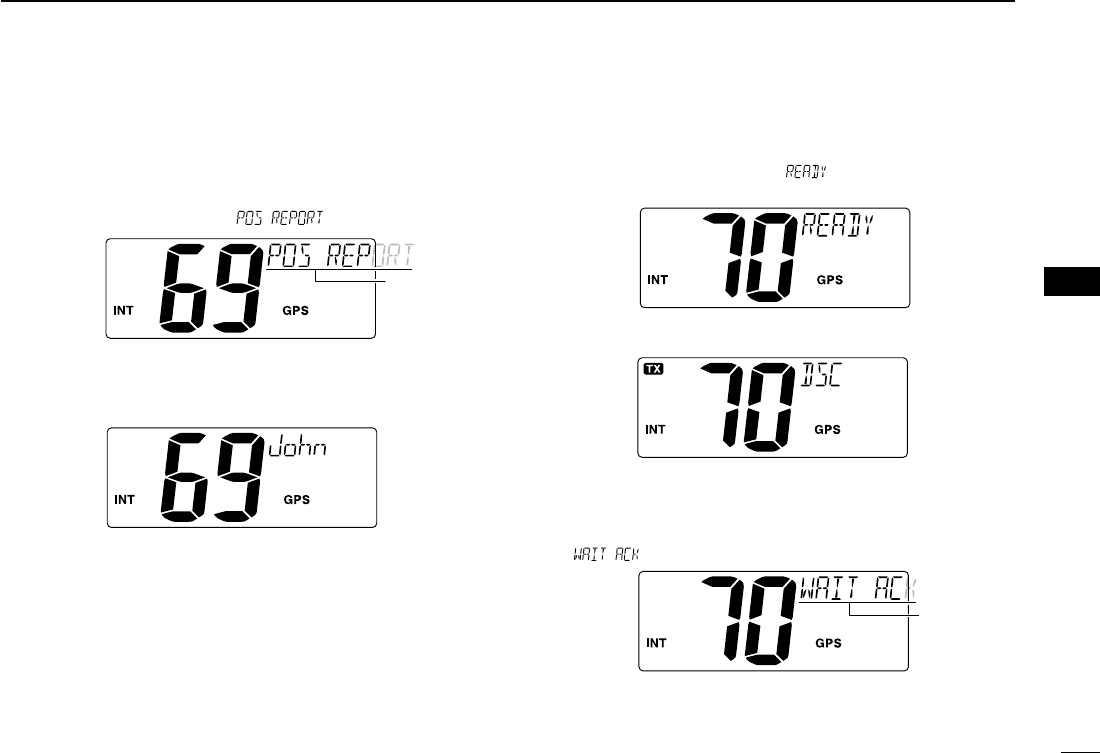
23
6
DSC OPERATION
New2001
6
DTransmitting a position report call
Transmit a position report call when you want to announce
your own position to a specific ship and to get an answer, etc.
qPush [DSC•POS]to enter the DSC menu.
wPush [Y]or [Z]to select “,” push [DSC•POS].
ePush [Y]or [Z] to select the desired pre-programmed in-
dividual address.
• The ID code must be set in advance. (p. 14)
rPush [DSC•POS]to enter the standby condition for posi-
tion report call.
• Channel 70 is selected and “” appears at the channel
comment indicator.
tPush [DSC•POS]to transmit the position report call.
yAfter the position report call has been transmitted, the fol-
lowing indication is displayed.
•“ ” scrolls at the channel comment indicator.
uPush any key to exit the condition and return to the previ-
ous indication before entering the DSC menu.
Scrolls
Transmitting
Scrolls
!IC-M422_FCC.qxd 05.1.14 11:30 AM Page 23 (1,1)
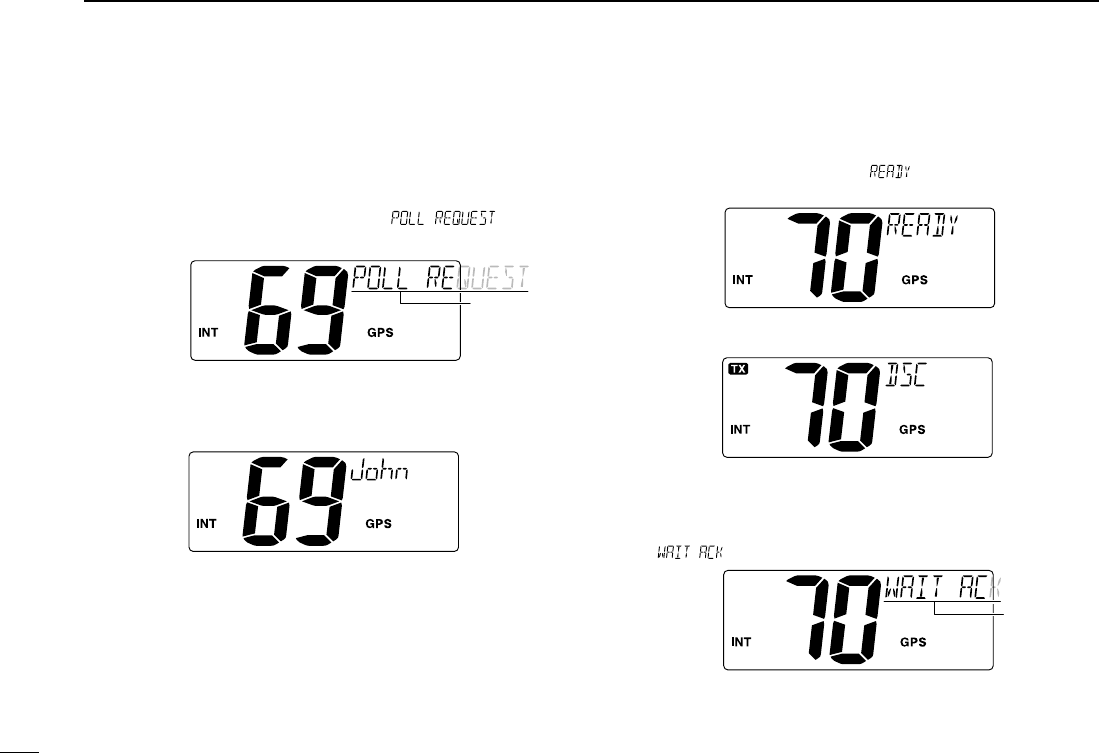
24
6DSC OPERATION
New2001
DTransmitting a polling request call
Transmit a polling request call when you want to know a spe-
cific ship is in the communication area, etc.
qPush [DSC•POS]to enter the DSC menu.
wPush [Y]or [Z]to select “,” push
[DSC•POS].
ePush [Y]or [Z] to select the desired pre-programmed in-
dividual address.
• The ID code must be set in advance. (p. 14)
rPush [DSC•POS]to enter the standby condition for polling
request call.
• Channel 70 is selected and “” appears at the channel
comment indicator.
tPush [DSC•POS]to transmit the polling request call.
yAfter the polling request call has been transmitted, the fol-
lowing indication is displayed.
•“ ” scrolls at the channel comment indicator.
uPush any key to exit the condition and return to the previ-
ous indication before entering the DSC menu.
Scrolls
Transmitting
Scrolls
!IC-M422_FCC.qxd 05.1.14 11:30 AM Page 24 (1,1)
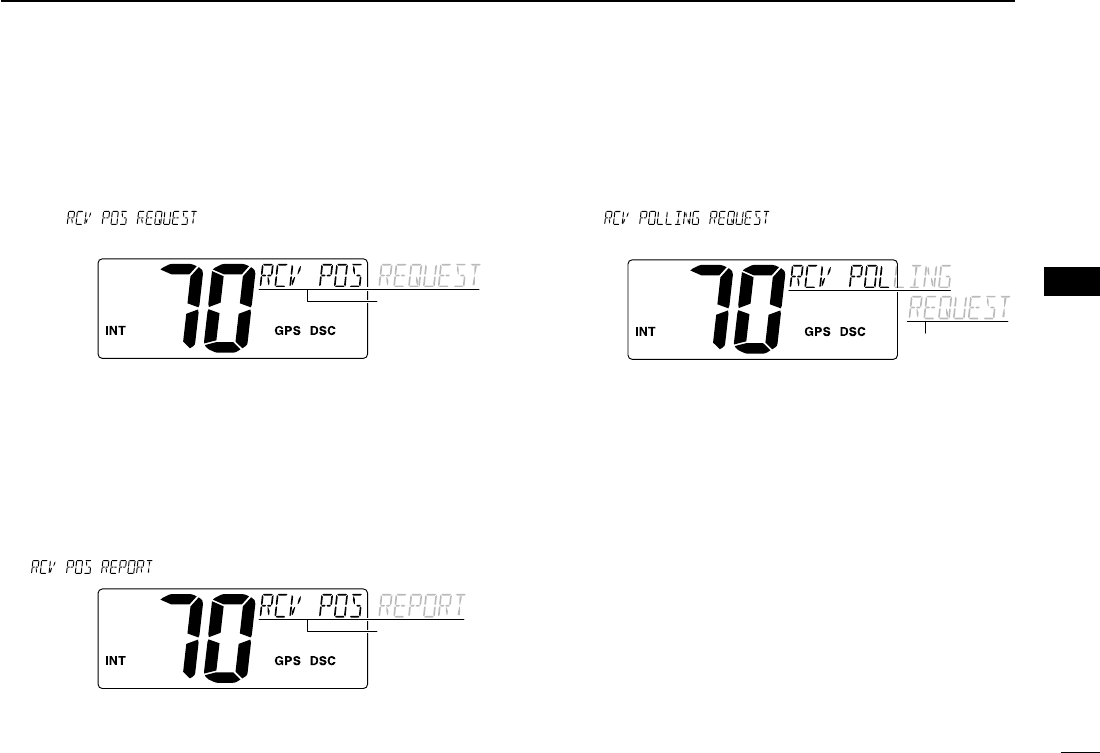
25
6
DSC OPERATION
New2001
6
DTransmitting a position request reply call
Transmit a position request reply call when a position request
call is received.
qWhen a position request call is received, “DSC” appears
and “” scrolls at the channel comment in-
dicator.
wPush [DSC•POS]to reply to the position request call; push
other key to ignore the position request call.
DTransmitting a position report reply call
Transmit a position report reply call when a position report call
is received.
qWhen a position report call is received, “DSC” appears and
“” scrolls at the channel comment indicator.
wPush [DSC•POS]to reply to the position report call; push
other key to ignore the position report call.
DTransmitting a polling request reply call
Transmit a polling request reply call when a polling request
call is received.
qWhen a polling request call is received, “DSC” appears
and “” scrolls at the channel com-
ment indicator.
wPush [DSC•POS]to reply to the polling request call; push
other key to ignore the polling request call.
Scrolls
Scrolls
Scrolls
!IC-M422_FCC.qxd 05.1.14 11:30 AM Page 25 (1,1)
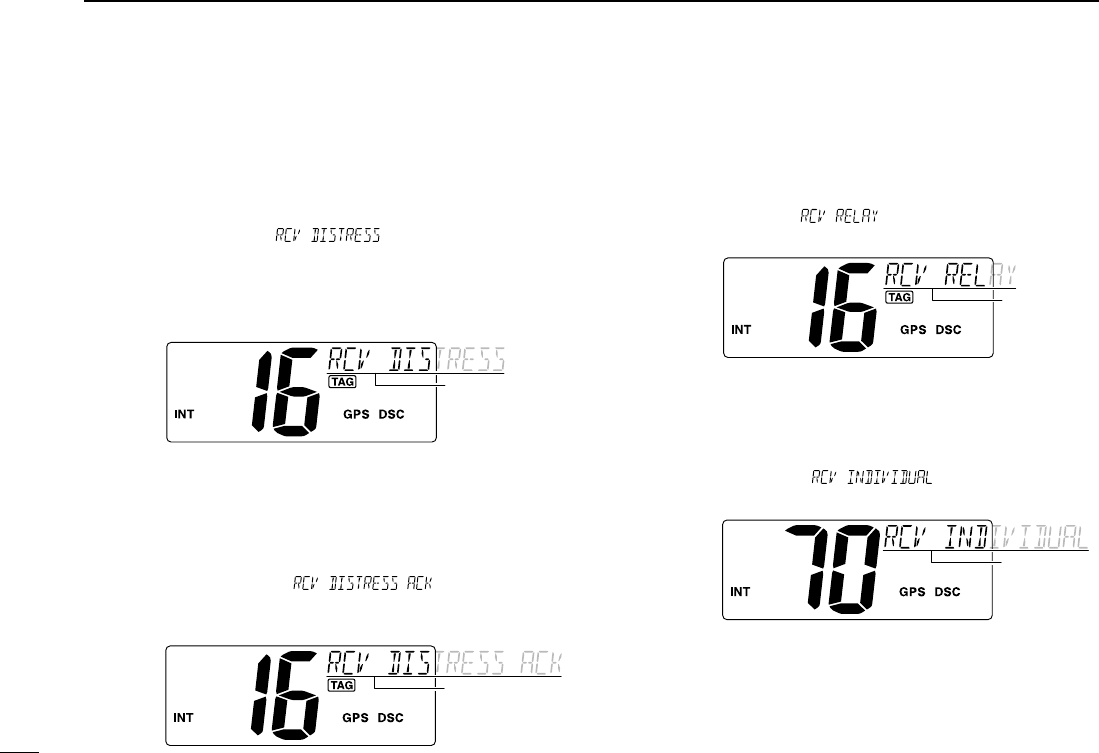
26
6DSC OPERATION
New2001
■Receiving DSC calls
DReceiving a distress call
While monitoring Channel 70 and a distress call is received:
➥The emergency alarm sounds for 2 minutes.
•Push any key to stop the alarm.
➥“DSC” appears and “” scrolls at the channel
comment indicator, then Channel 16 is selected automati-
cally.
➥Continue monitoring Channel 16 as a coast station may re-
quire assistance.
DReceiving a distress acknowledgement
While monitoring Channel 70 and a distress acknowledge-
ment to other ship is received:
➥The emergency alarm sounds for 2 minutes.
•Push any key to stop the alarm.
➥“DSC” appears and “” scrolls at the
channel comment indicator, then Channel 16 is selected
automatically.
DReceiving a distress relay call
While monitoring Channel 70 and a distress relay acknowl-
edgement is received:
➥The emergency alarm sounds for 2 minutes.
•Push any key to stop the alarm.
➥“DSC” appears and “” scrolls at the channel com-
ment indicator, then Channel 16 is selected automatically.
DReceiving an individual call
While monitoring Channel 70 and an individual call is received:
➥The emergency alarm or beeps sound depending on the
received category.
➥“DSC” appears and “” scrolls at the chan-
nel comment indicator.
➥Push any key to stop the beep, then push [DSC•POS]to
reply the call and select the channel specified by the calling
station for voice communication (depending on your reply-
ing condition. See p, 18 for individual acknowledgement call
procedure for details.); push any other key to ignore the call.
Scrolls
Scrolls
Scrolls
Scrolls
!IC-M422_FCC.qxd 05.1.14 11:30 AM Page 26 (1,1)
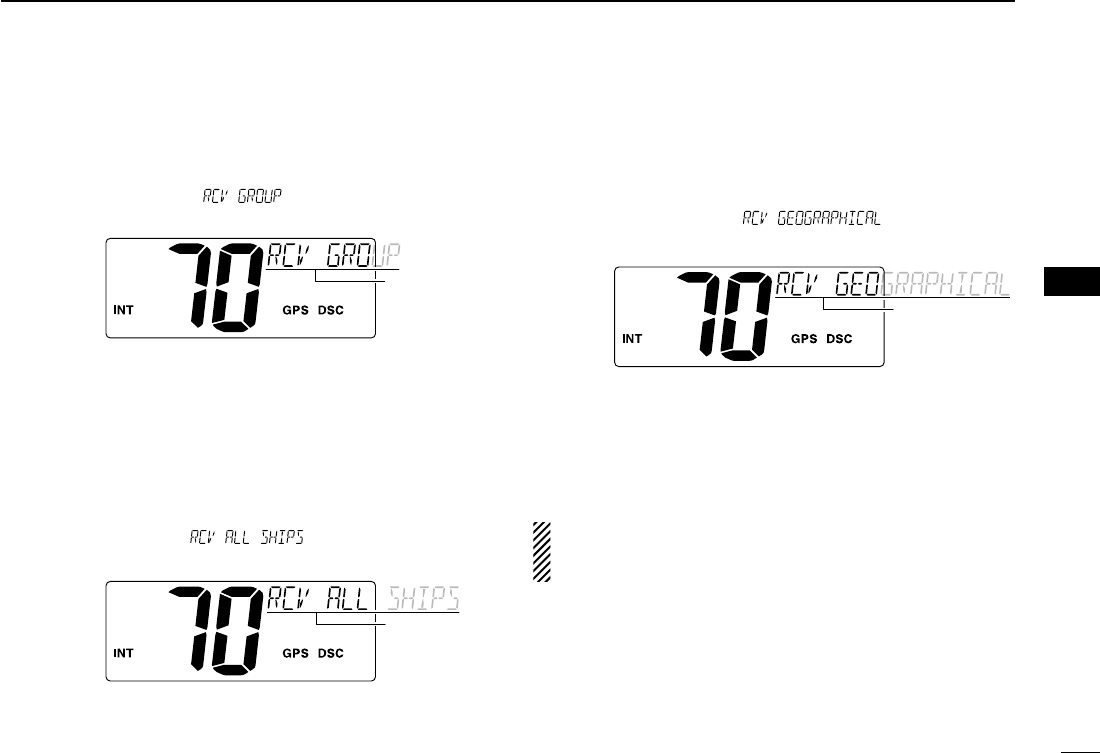
27
6
DSC OPERATION
New2001
6
DReceiving a group call
While monitoring Channel 70 and a group call is received:
➥The emergency alarm or beeps sound depending on the
received category.
➥“DSC” appears and “” scrolls at the channel
comment indicator.
➥Push any key to stop the beep, then push [DSC•POS]to
select the channel specified by the calling station for voice
communication; push any other key to ignore the call.
DReceiving an all ships call
While monitoring Channel 70 and an all ships call is received:
➥The emergency alarm sounds when the category is ‘Dis-
tress’or ‘Urgency’; 2 beeps sound for other categories.
➥“DSC” appears and “” scrolls at the channel
comment indicator.
➥Push any key to stop the beep, then push [DSC•POS]to
monitor Channel 16 for an announcement from the calling
vessel, push any other key to ignore the call.
DReceiving a geographical area call
While monitoring Channel 70 and a geographical area call
(for the area you are in) is received:
➥The emergency alarm or beeps sound depending on the
received category.
➥“DSC” appears and “” scrolls at the
channel comment indicator.
➥Push any key to stop the beep, then push [DSC•POS]to
select the channel specified by the calling station for voice
communication; push any other key to ignore the call.
➥Monitor the selected channel for an announcement from
the calling station.
When no GPS receiver is connected or if there is a prob-
lem with the connected receiver, all geographical area calls
are received, regardless of your position.
Scrolls
Scrolls
Scrolls
!IC-M422_FCC.qxd 05.1.14 11:30 AM Page 27 (1,1)
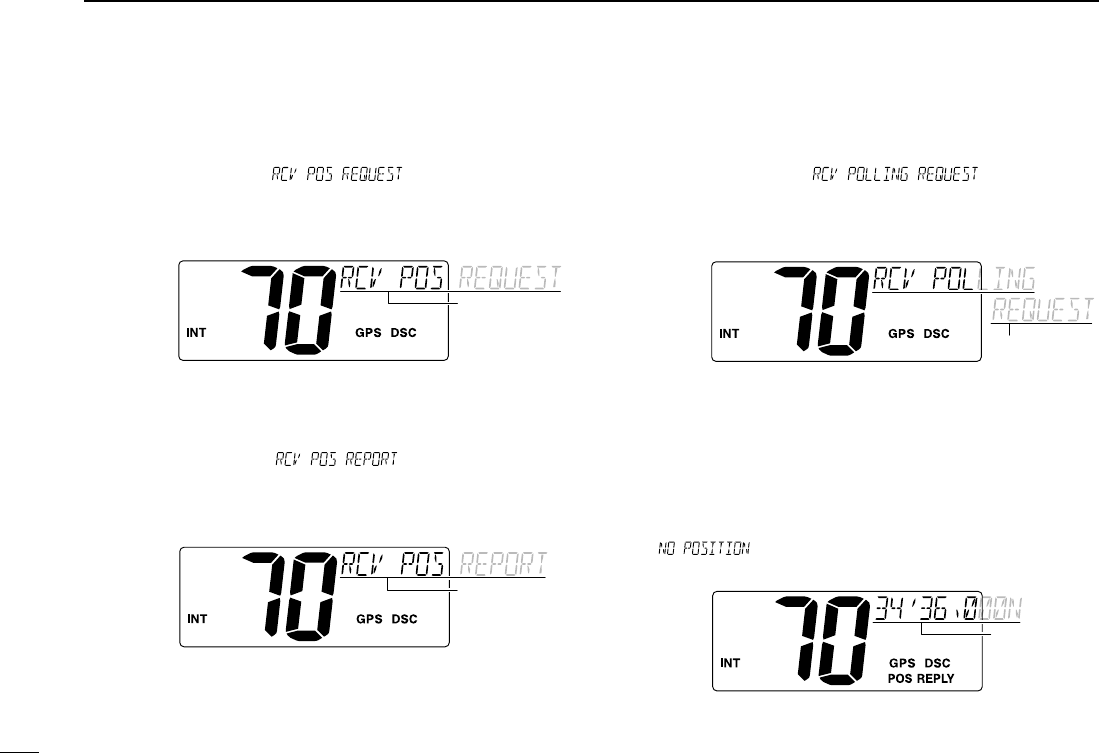
28
6DSC OPERATION
New2001
DReceiving a position request call
While monitoring Channel 70 and a position request call is re-
ceived:
➥“DSC” appears and “” scrolls at the chan-
nel comment indicator.
➥Push any key to stop the beep, then push [DSC•POS]to
reply to the call; push any other key to ignore the call.
DReceiving a position report call
While monitoring Channel 70 and a position report call is re-
ceived:
➥“DSC” appears and “” scrolls at the chan-
nel comment indicator.
➥Push any key to stop the beep, then push [DSC•POS]to
reply to the call; push any other key to ignore the call.
DReceiving a polling request call
While monitoring Channel 70 and a polling request call is re-
ceived:
➥“DSC” appears and “” scrolls at the
channel comment indicator.
➥Push any key to stop the beep, then push [DSC•POS]to
reply to the call; push any other key to ignore the call.
DReceiving a position request reply call
While monitoring Channel 70 and a position request reply call
is received:
➥“DSC” and “POS REPLY” appear in the display.
•The ‘Latitude’and ‘Longitude’from the called station is displayed
and scrolled at the channel comment indicator in order of Lati-
tude co-ordinates and then Longitude co-ordinates.
• “” scrolls when no GPS is connected.
➥Push any key to stop the beep.
Scrolls
Scrolls
Scrolls
Scrolls
!IC-M422_FCC.qxd 05.1.14 11:31 AM Page 28 (1,1)
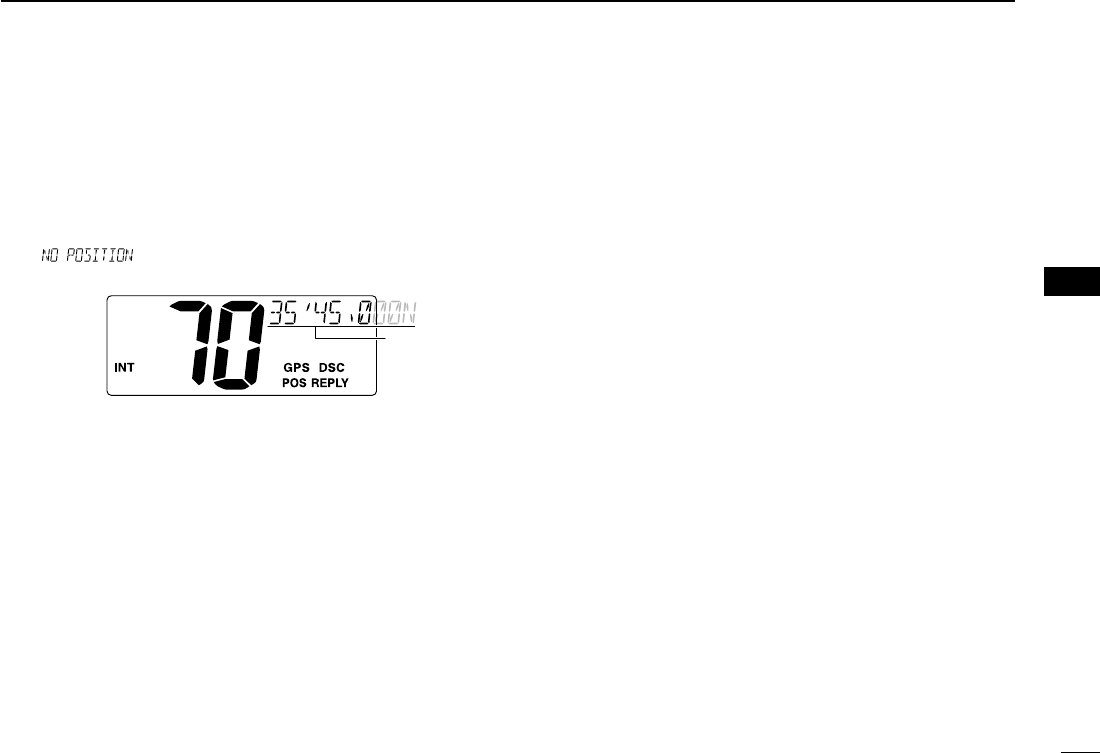
29
6
DSC OPERATION
New2001
6
DReceiving a position report reply call
While monitoring Channel 70 and a position report reply call
is received:
➥“DSC” and “POS REPLY” appear in the display.
•The ‘Latitude’and ‘Longitude’you have sent is displayed and
scrolled at the channel comment indicator in order of Latitude
co-ordinates and then Longitude co-ordinates.
• “” scrolls when no GPS is connected.
➥Push any key to stop the beep.
Scrolls
!IC-M422_FCC.qxd 05.1.14 11:31 AM Page 29 (1,1)

30
11 CHAPTER CONTINUED
New2001
!IC-M422_FCC.qxd 05.1.14 11:31 AM Page 30 (1,1)
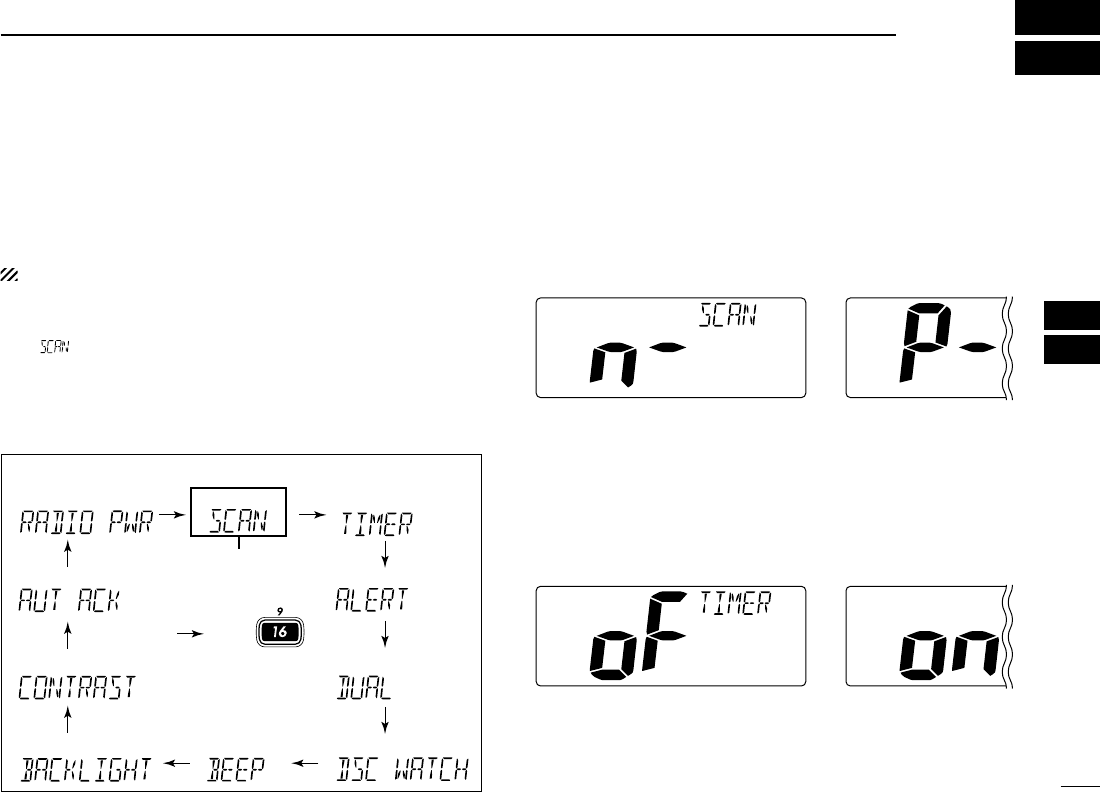
31
7
SET MODE
6
7
■Set mode programming
Set mode is used to change the conditions of the transceiver’s
functions: Scan type (Normal or Priority,) Scan resume timer,
Weather alert, Dual/Tri-watch, DSC watch, Beep tone (trans-
ceiver,) LCD backlight, LCD contrast, Auto ACK and Radio PWR.
Available functions may differ depending on dealer setting.
qTurn power OFF.
wWhile pushing [16•9], turn power ON to enter set mode.
• “” appears at the channel comment indicator.
eAfter the display appears, release [16•9].
rPush [16•9]to select the desired item, if necessary.
tPush [Y]or [Z]to select the desired condition of the item.
yTurn power OFF, then ON again to exit set mode.
■SET mode items
DScan type
The transceiver has 2 scan types: Normal scan and Priority
scan. Normal scan searches all tag channels in the selected
channel group. Priority scan searches all tag channels in se-
quence while monitoring Channel 16.
DDScan resume timer
The scan resume timer can be selected as a pause (OFF) or
timer scan (ON). When OFF is selected, the scan pauses
until the signal disappears. When ON is selected, the scan
pauses 5 sec. and resumes even if a signal has been re-
ceived on any other channel than Channel 16.
Scan timer OFF (default) Scan timer ON
Normal scan (default) Priority scan
DSET MODE CONSTRUCTION
: Push
• Beep tone
• Backlight
• LCD contrast
• Radio PWR
Starting item
• Scan type • Scan resume timer
• Weather alert
• Dual/Tri-watch
• DSC watch
• Auto
acknowledgement
!IC-M422_FCC.qxd 05.1.14 11:31 AM Page 31 (1,1)
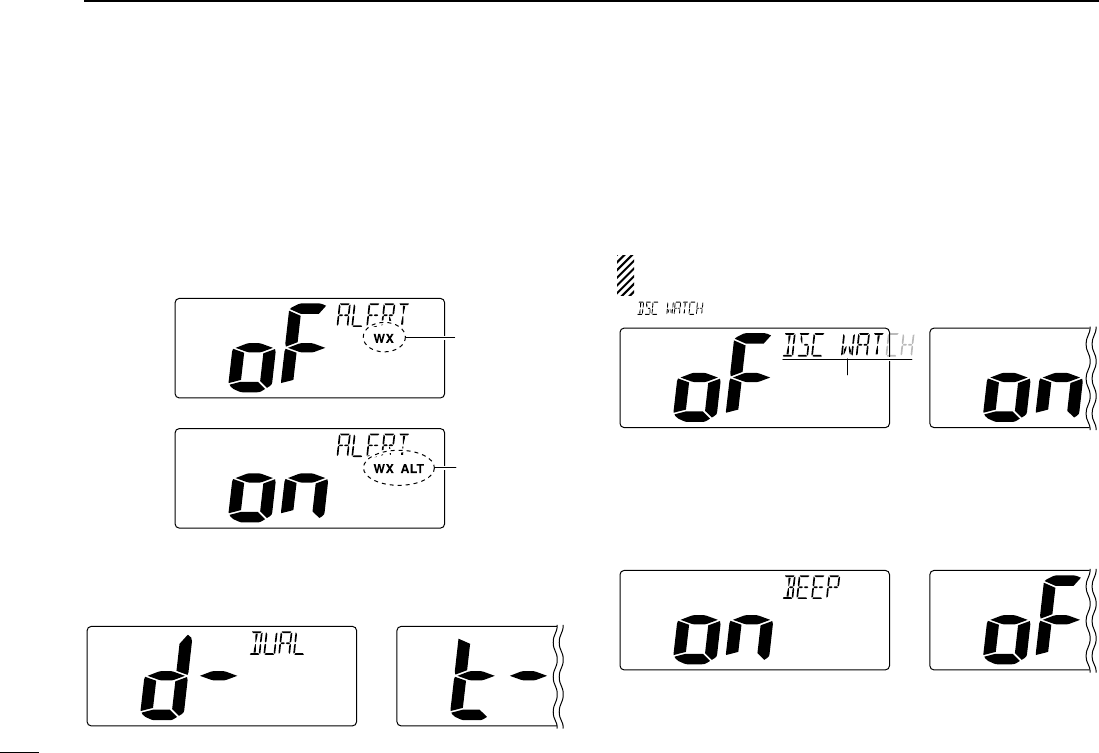
32
7SET MODE
New2001
DDWeather alert
A NOAA broadcast station transmits a weather alert tone be-
fore important weather information. When the weather alert
function is turned ON, the transceiver detects the alert, then
the “WX ALT” indicator blinks until the transceiver is operated.
The previously selected (used) weather channel is checked
any time during standby or while scanning.
•“WX ALT” appears instead of “WX” indication when the function is
set ON.
DDDual/Tri-watch
This item can be selected as dualwatch or tri-watch. (p. 12)
DDDSC watch
DSC watch monitors Channel 70 while you are receiving an-
other channel.
If a distress signal is received on Channel 70, the transceiver
monitors Channel 16 and 70 alternately until the distress sig-
nal disappears. If a signal is received on another channel,
DSC watch pauses until the signal disappears.
This function may not be available for some channel
groups depending on dealer setting.
• “” scrolls at the channel comment indicator.
DDBeep tone
You can select the silent operation by turning beep tones OFF
or you can have confirmation beeps sound at the push of a
key by turning beep tones ON.
Beep tone ON (default) Beep tone OFF
DSC watch OFF (default) DSC watch ON
Scrolls
Dualwatch (default) Tri-watch
Weather alert OFF (default)
Weather alert ON
Appears
Appears
!IC-M422_FCC.qxd 05.1.14 11:31 AM Page 32 (1,1)
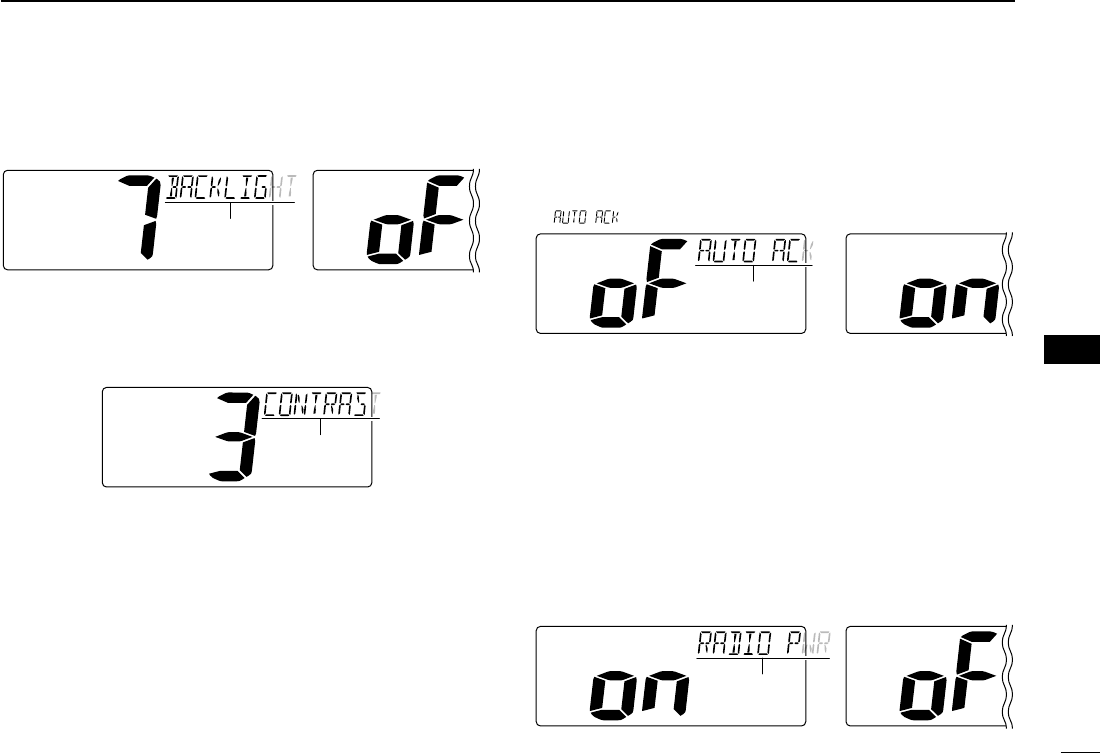
33
7
SET MODE
New2001
8
DDLCD backlight
The LCD backlight brightness can be adjusted from OFF, 1
(dark) to 7 (bright.)
DDLCD contrast
The LCD contrast can be adjustable in 4 levels. 1 is the low-
est contrast, and 4 is the highest contrast.
DDAutomatic acknowledgement
This item sets the automatic acknowledgement function ON
or OFF. When position request, position report or polling re-
quest call is received, transceiver automatically transmits the
reply call, respectively.
• “” scrolls at the channel comment indicator.
DDRadio power
(Available only when optional HM-157
COMMANDMIC II
™is
connected to the transceiver.)
This item sets the radio power function ON or OFF.
ON : The transceiver’s power is controlled by the HM-157.
When the HM-157 is turned OFF, the transceiver will
also be turned OFF automatically.
OFF : The transceiver’s power is not controlled by the HM-
157. Even if the HM-157 is turned OFF, the transceiver
will continue to work.
Radio PWR ON (default) Radio PWR OFF
Scrolls
Auto acknowledgement
OFF (default)
Auto acknowledgement
ON
Scrolls
LCD contrast level 3 (default)
Scrolls
LCD backlight level 7 (default) LCD backlight OFF
Scrolls
!IC-M422_FCC.qxd 05.1.14 11:31 AM Page 33 (1,1)
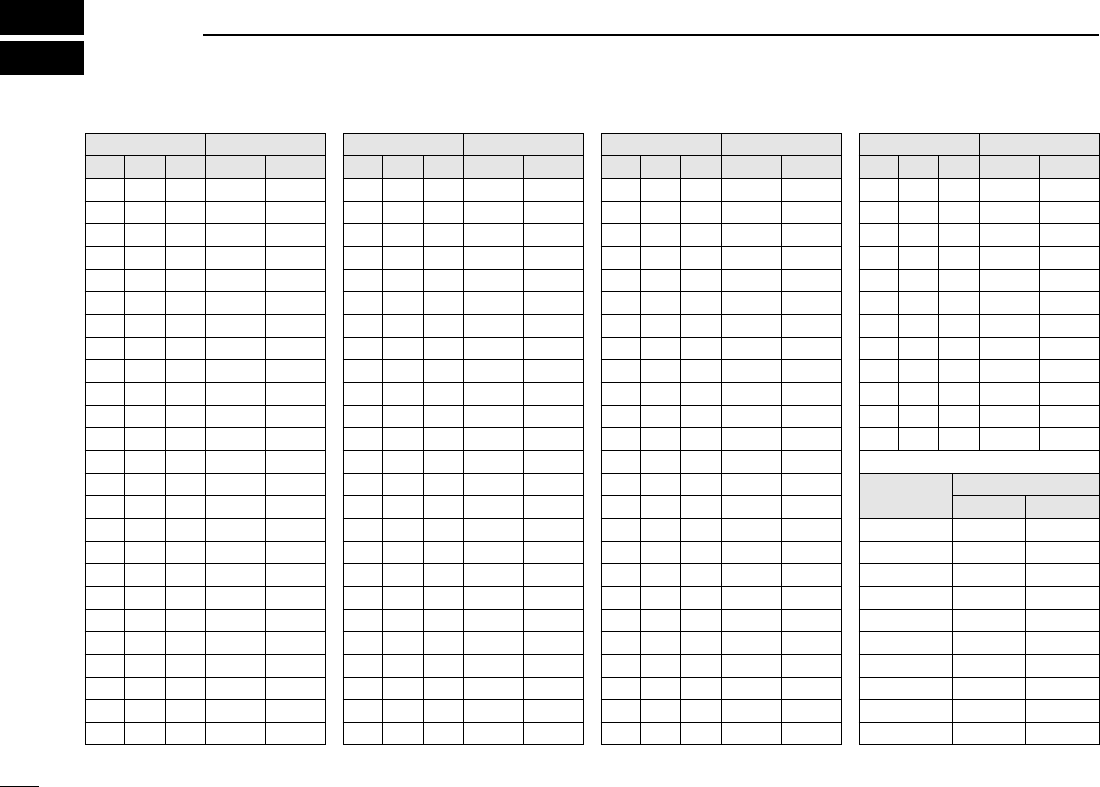
34
CHANNEL LIST
New2001New2001
8
Channel number
USA CAN
Transmit
Receive
01 156.050 160.650
01A 156.050 156.050
02 156.100 160.700
03 156.150 160.750
03A 156.150 156.150
156.200 160.800
04A 156.200 156.200
156.250 160.850
05A 05A 156.250 156.250
06 06 156.300 156.300
156.350 160.950
07A 07A 156.350 156.350
08 08 156.400 156.400
09 09 156.450 156.450
10 10 156.500 156.500
11 11 156.550 156.550
12 12 156.600 156.600
13
*2
13
*1
156.650 156.650
14 14 156.700 156.700
15
*2
15
*1
156.750 156.750
16 16 156.800 156.800
17
*1
17
*1
156.850 156.850
156.900 161.500
18A 18A 156.900 156.900
Frequency (MHz)
INT
01
02
03
04
05
06
07
08
09
10
11
12
13
14
15
*1
16
17
18
Channel number Frequency (MHz)
USA CAN
Transmit
Receive
19A 19A 156.950 156.950
20 20
*1
157.000 161.600
21 157.050 161.650
21A 21A 157.050 157.050
157.100 161.700
22A 22A 157.100 157.100
23 157.150 161.750
23A 157.150 157.150
24 24 157.200 161.800
25 25 157.250 161.850
26 26 157.300 161.900
27 27 157.350 161.950
28 28 157.400 162.000
60 156.025 160.625
156.075 160.675
61A 61A 156.075 156.075
156.125 160.725
62A 156.125 156.125
156.175 160.775
63A 156.175 156.175
64 156.225 160.825
INT
20
21
22
23
24
25
26
27
28
60
61
62
63
64
20A 157.000 157.000
Channel number
66A
Frequency (MHz)
66A
*1
USA CAN
Transmit
Receive
64A 64A 156.225 160.825
65A 65A 156.275 156.275
156.325 160.925
67
*2
67 156.375 156.375
68 68 156.425 156.425
69 69 156.475 156.475
70
*3
70
*3
156.525 156.525
71 71 156.575 156.575
72 72 156.625 156.625
73 73 156.675 156.675
74 74 156.725 156.725
77
*1
77
*1
156.875 156.875
156.925 161.525
78A 78A 156.925 156.925
156.975 161.575
79A 79A 156.975 156.975
157.025 161.625
80A 80A 157.025 157.025
157.075 161.675
81A 81A 157.075 157.075
157.125 161.725
82A 82A 157.125 157.125
INT
65A
66
67
68
69
70
*3
71
72
73
74
77
78
79
80
81
82
156.325 156.32566A
Channel number
84A
Frequency (MHz)
USA CAN
Transmit
Receive
83A 83A 157.175 157.175
84 84 157.225 161.825
85 85 157.275 161.875
85A 157.275 157.275
86 86 157.325 161.925
86A 157.325 157.325
87 87 157.375 161.975
87A 157.375 157.375
88 88 157.425 162.025
88A 157.425 157.425
INT
84
85
86
87
88
157.225 157.225
WX channel
4
Frequency (MHz)
Transmit Receive
1 RX only 162.550
2 RX only 162.400
3 RX only 162.475
5 RX only 162.450
6 RX only 162.500
7 RX only 162.525
8 RX only 161.650
9 RX only 161.775
10 RX only 163.275
RX only 162.425
*1
Low power only.
*3
DSC operation only
156.950 161.55019
21b Rx only 161.650
25b Rx only 161.850
156.275 160.87565
28b Rx only 162.000
83 157.175 161.77583
83b Rx only 161.775
*2
Momentary high power.
NOTE: Simplex channels, 3, 21, 23, 61, 64, 81, 82 and 83 CANNOT
be lawfully used by the general public in U.S.A. waters.
!IC-M422_FCC.qxd 05.1.14 11:31 AM Page 34 (1,1)

35
9
SPECIFICATIONS AND OPTIONS
8
9
New2001
■Specifications
DDGeneral
•Frequency coverage :
Transmit 156.025–157.425 MHz
Receive 156.050–163.275 MHz
•Mode : FM (16K0G3E), DSC(16K0G2B)
•Channel spacing : 25 kHz
•Current drain (at 13.8 V) : TX high 5.5 A max.
Max. audio 1.5 A max.
•Power supply requirement : 13.8 V DC
•Frequency stability : ±10 ppm
(–20°C to +60°C; –4°F to +140°F)
•Dimensions : 164(W) ×78(H) ×154(D) mm
(Projections not included) 6 15⁄32(W) ×3 1⁄16(H)×6 1⁄16(D) in
•Weight : Approx. 1070 g ; 2.3 lb
DDTransmitter
•Output power : 25 W/1 W
•Modulation system : Variable reactance frequency
modulation
•Max. frequency deviation : ±5.0 kHz
•Spurious emissions : Less than –70 dB
DDReceiver
•Receive system : Double conversion superheterodyne
•Sensitivity (12 dB SINAD) : 0.22µV (typical)
•Squelch sensitivity : 0.22µV
•Intermodulation rejection ratio : More than 70 dB
•
Spurious response rejection ratio
: More than 70 dB
•Adjacent channel selectivity : More than 70 dB
•Audio output power : 4.5W (typical) at 10% distortion
with a 4 Ωload
All stated specifications are subject to change without notice or
obligation.
■Options
•MB-69
FLUSH MOUNT KIT
For mounting the transceiver to a panel.
•HM-157
COMMANDMIC II
™
External microphone-type controller. Provides optional inter-
com operation. 6 m (20 feet) microphone cable and mount-
ing base included. Black and white colours are available.
•OPC-999
MICROPHONE EXTENSION CABLE
6 m (20 feet) microphone extension cable for optional HM-
157
COMMANDMIC II
™. Up to 2 OPC-999 can be connected.
(18 m; 60 feet maximum)
!IC-M422_FCC.qxd 05.1.14 11:31 AM Page 35 (1,1)
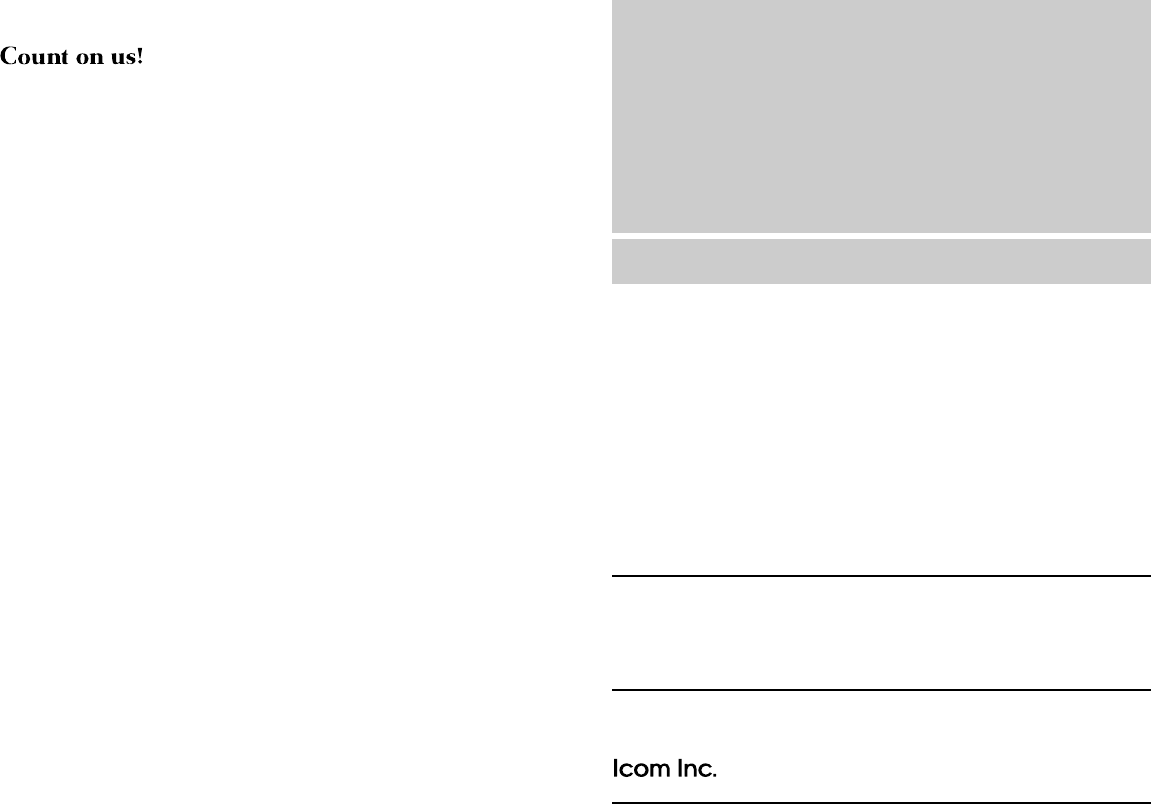
1-1-32 Kamiminami, Hirano-ku, Osaka 547-0003, Japan
A-6431?-1US
Printed in Japan
©2005 Icom Inc.
New2001
!IC-M422_FCC.qxd 05.1.14 11:31 AM Page 36 (1,1)